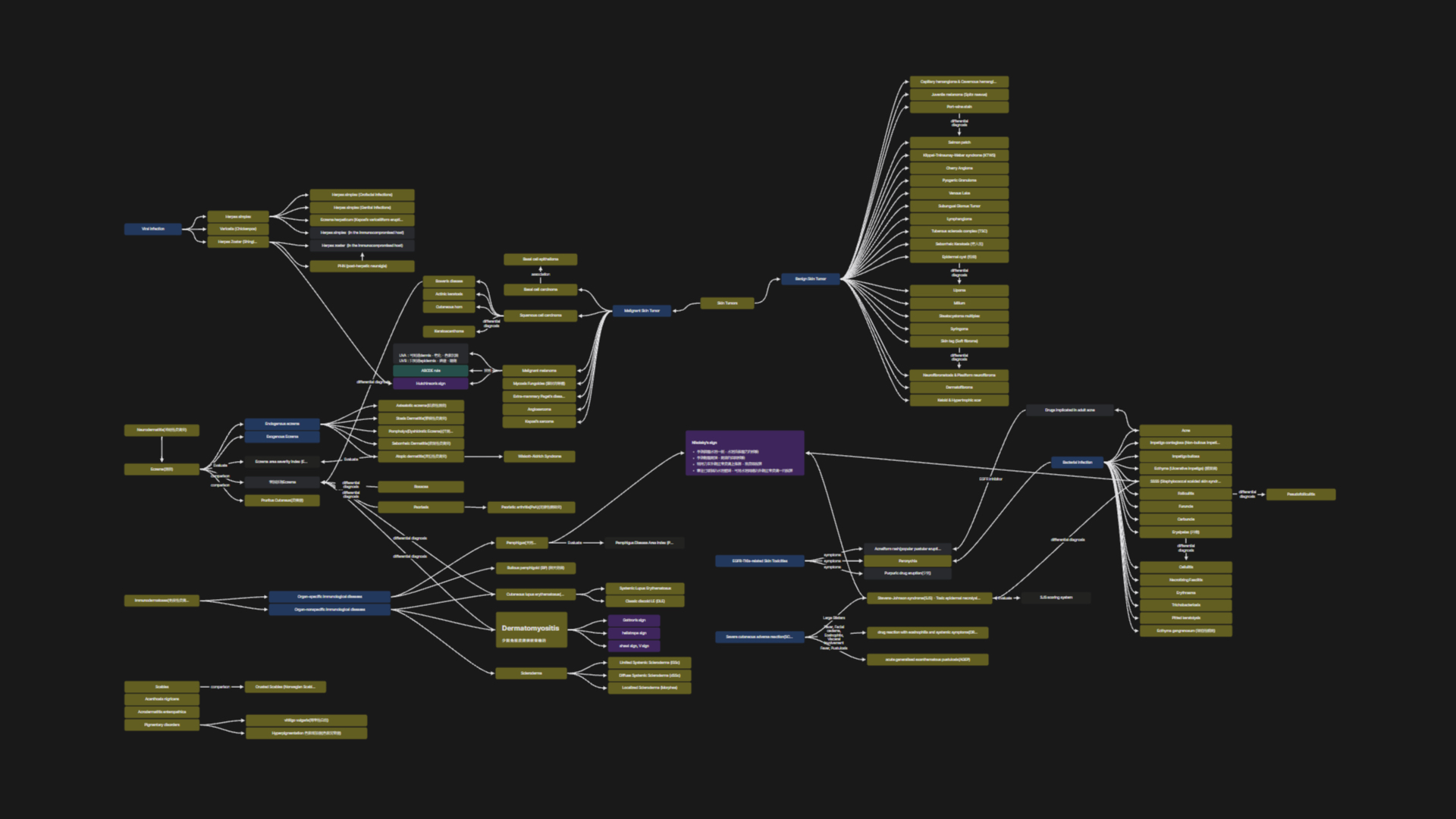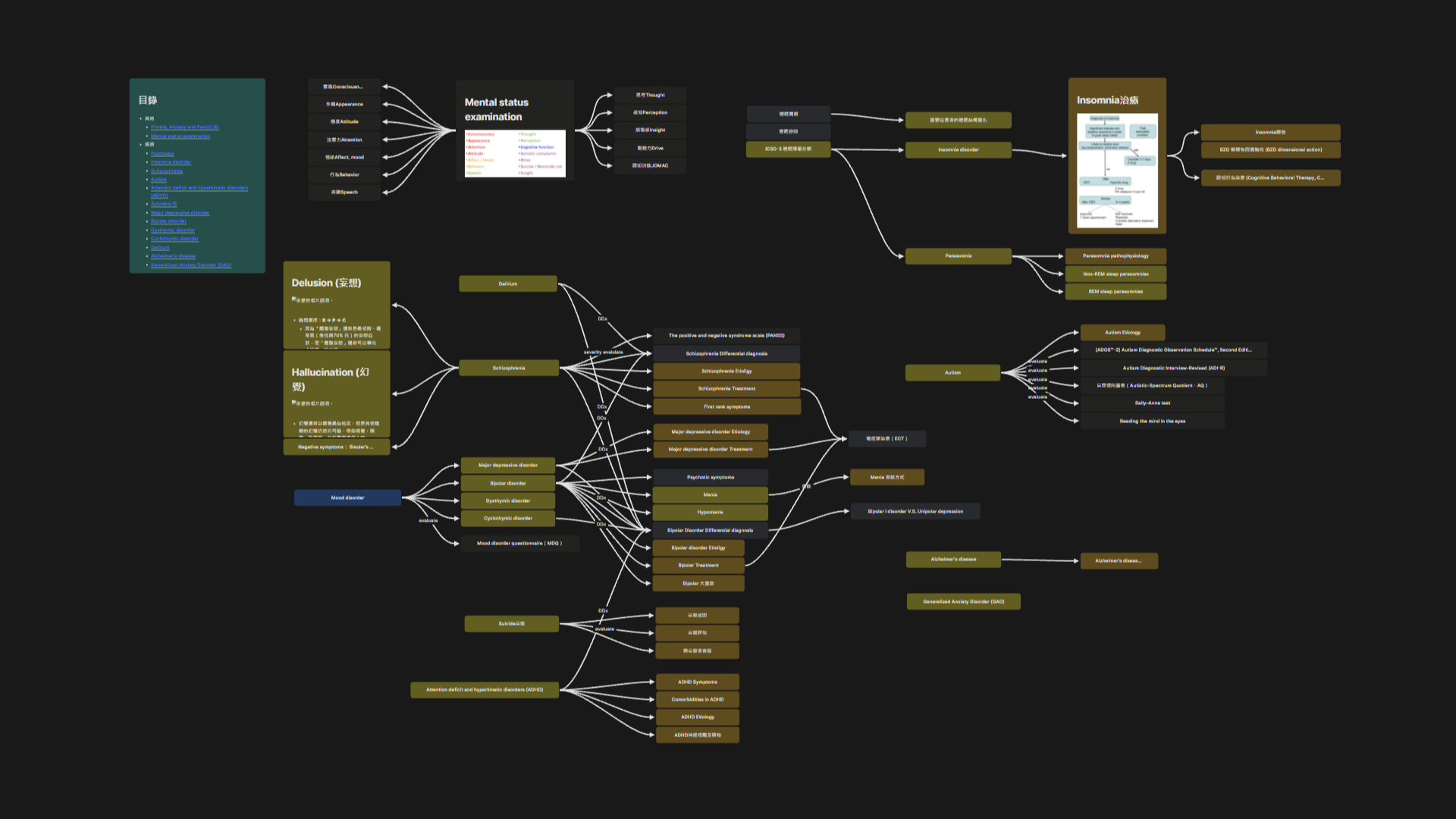Old Use Case (2021): Creative Research, Market Research, Medical Learning
Startup Research - 新創公司研究
I'm Alan Chan, one the co-founders of Heptabase. Heptabase is a knowledge management tool that helps you learn, do research, and make sense of complex topics. I'll demonstrate how I'm using Heptabase to run my company in the following examples.
我是詹雨安,Heptabase 的共同創辦人。Heptabase 是一個幫助你學習、研究和理解複雜主題的知識管理工具。在下面的幾個範例中,我會示範我如何用 Heptabase 來經營我的新創公司。
Learn the Methodology - 學習方法論
Play with some example whiteboards: Startup Notes, Data Analytics Notes
When building a startup, I often read articles from Y Combinator's Startup Library and try to apply what I've learned to what I'm doing.
These articles contain a large amount of information, and the ideas presented in different articles may be related or conflicting. To organize my learning notes more effectively, I created a whiteboard for each large topic and put all the notes of the articles related to that topic into the whiteboard. For each article, I created a card to write an outline. For longer articles, I further broke the content down into different cards based on key points and put an excerpt of what I've chosen or some of my thoughts in each card.
By doing this, I can come back to the whiteboard and quickly find the knowledge that will help me make any decision in the future.
在創業的過程中,我常常會去 Y Combinator 的 Startup Library 找文章來讀,並嘗試將所學應用到當前在做的事情上。
這些文章的內容資訊量龐大,不同文章之間提出的觀點可能互有關聯或衝突。為了能更有效地整理我的學習筆記,我會針對每一個比較大的主題開一個白板,並把所有跟該主題有關的文章筆記都塞進這個白板裡頭。對於每一篇文章,我都會建立一張卡片來寫大綱。對於比較長的文章,我會進一步將內容依照重點拆成多張不同的卡片,在每張卡片裡頭放入我選出的內容節錄,或是一些我自己的想法。
透過這樣的做法,未來我在做任何決策時,我都可以回到這個白板裡頭,快速地找到可以幫助我做決策的知識。
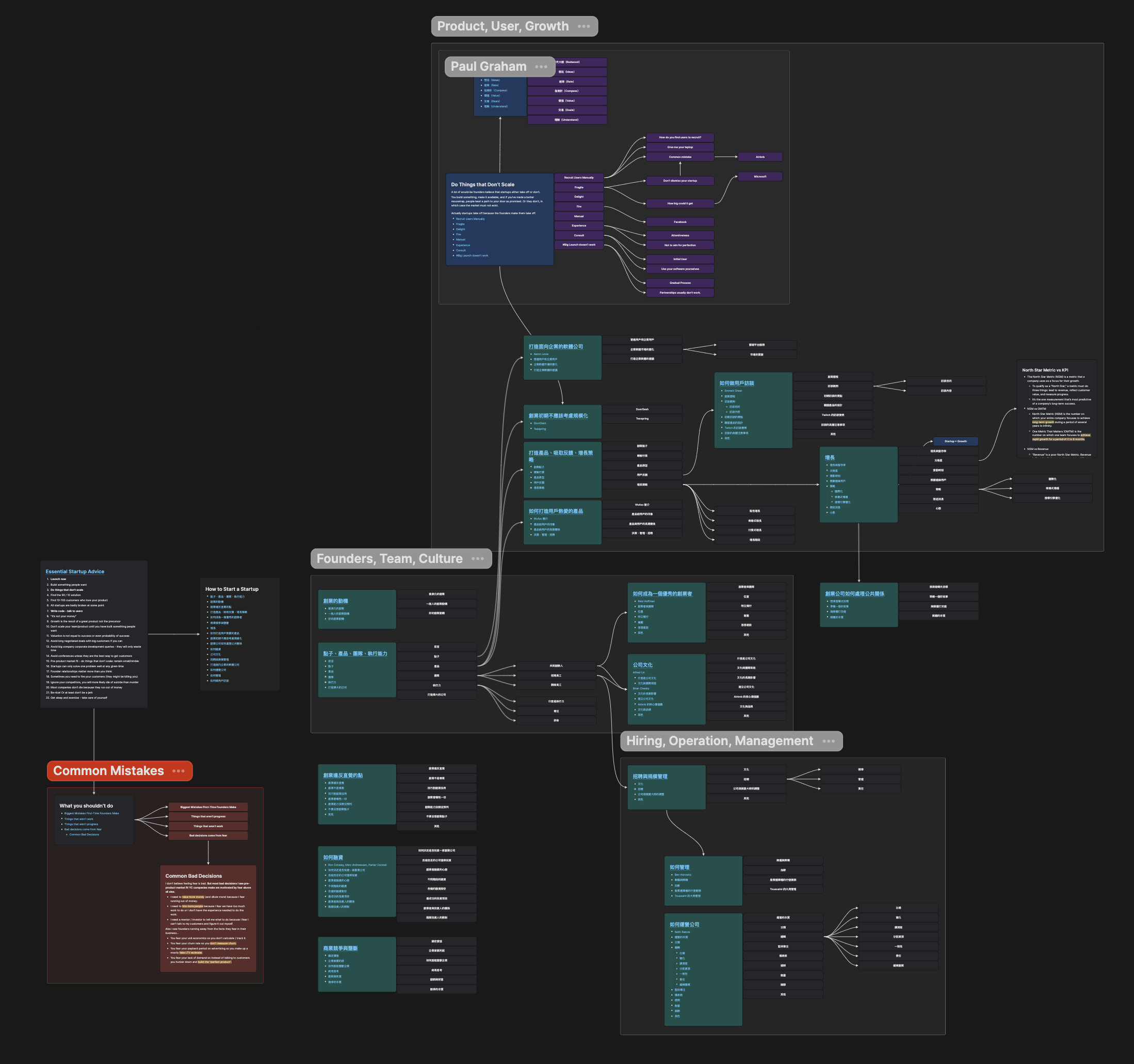
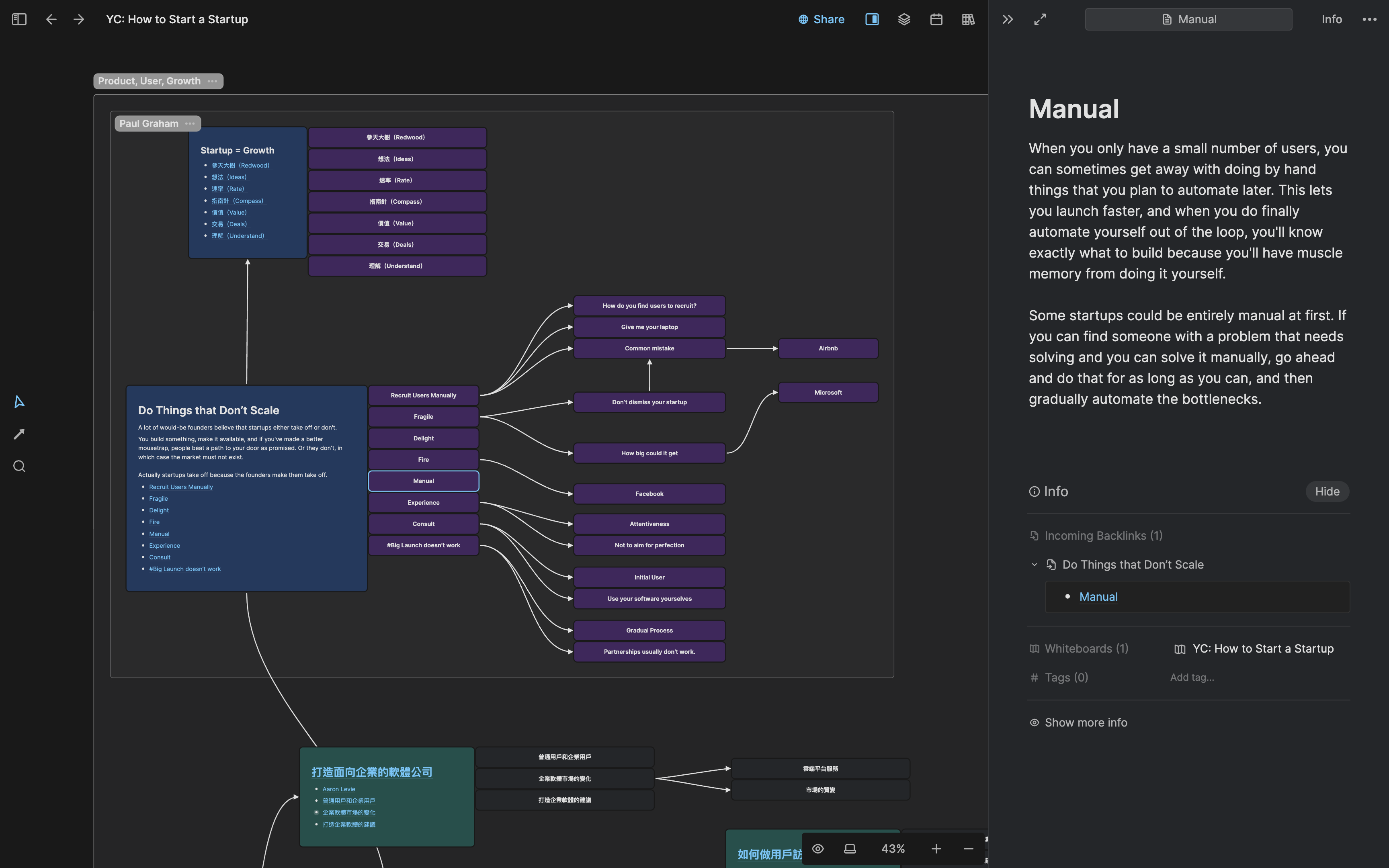
Set the OKRs and the Value Proposition - 設定目標和價值主張
Every startup has a problem it wants to solve, a unique value proposition, and some goals it wants to achieve. I have a whiteboard for this kind of information. In this whiteboard, I wrote down the goals of the product and extended from these goals some possible solutions. Sometimes, when I got too wrapped up in the development details and can't see the big picture very well, I came to this whiteboard and reexamined the product goals and add new ideas.
每一家公司都有它想解決的問題、它獨特的價值主張、以及它想達到的目標。我有一個白板就是專門拿來放這一類的資訊。在這個白板裡,我寫下了我的產品想達成的目標,並從這個目標往外延伸出一些可能的解決方案。有時候我覺得自己太過投入在開發細節上,有點看不清產品整體的大方向時,就會跑到這個白板上重新審視這些產品目標,並加入新的想法。
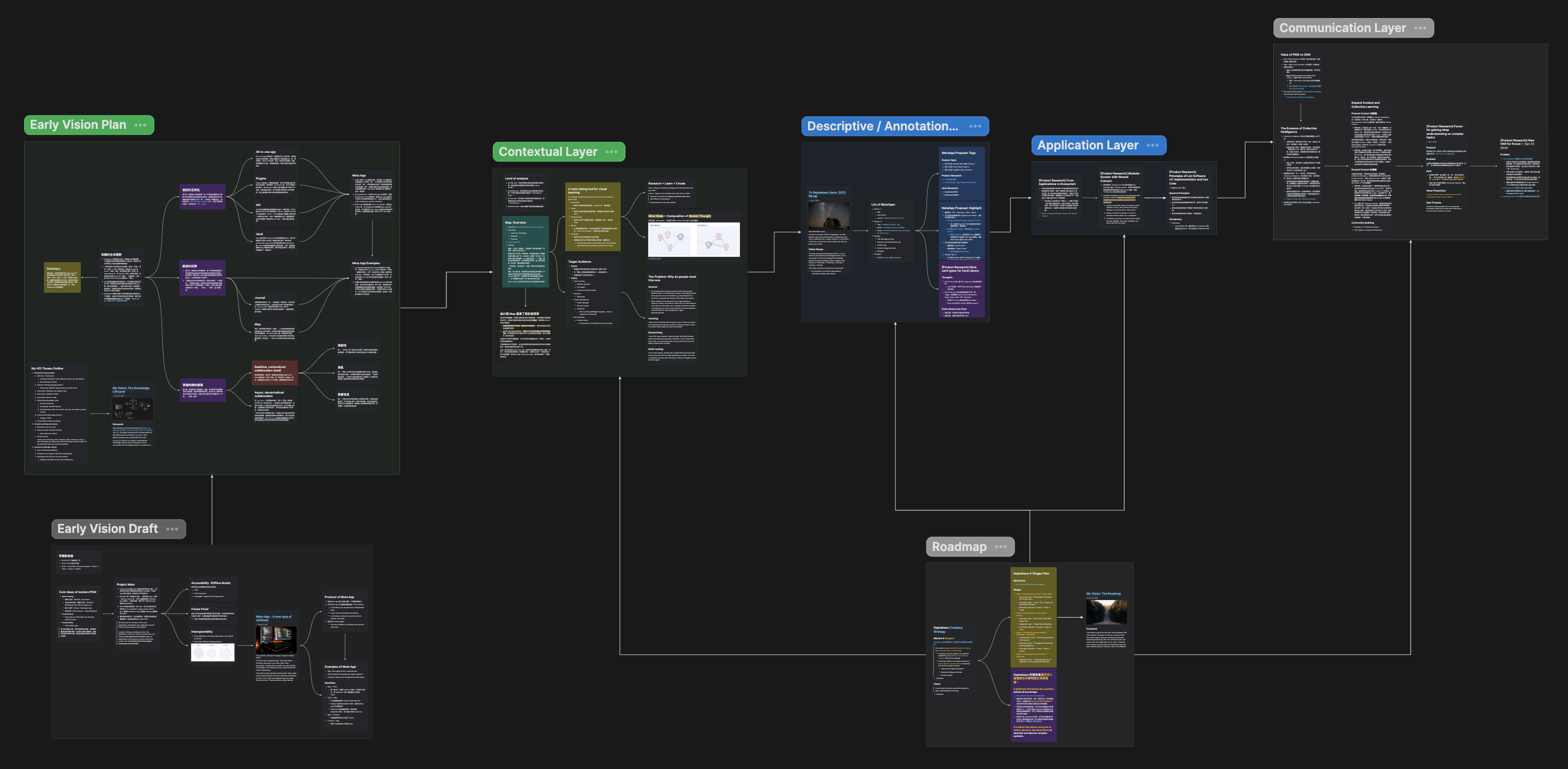
Keep track on what I know and what I don't know - 釐清重要問題的答案
To build a successful startup, in addition to the user experience, many aspects such as the team, the market, and the acquisition channels must also be thought clearly. I have a whiteboard that I use to help me clarify these big questions. I would make a blue "question card" for each question and then write my thoughts around the card. When my answers took shape, I will merge them into the question cards and changed the color to green.
一家公司要成功,除了產品本身的體驗要做好之外,產品背後的團隊、產品服務的市場、產品獲取用戶的方式等諸多面向也都得思考清楚。我有一個白板就是專門用來幫助我釐清這些問題的答案。我會先將要回答的問題作成一張藍色的「問題卡片」,接著在這張卡片周圍寫下我的想法。當我的答案慢慢成形後,我會再將答案整合到問題卡片裡頭,並把顏色換成綠色。
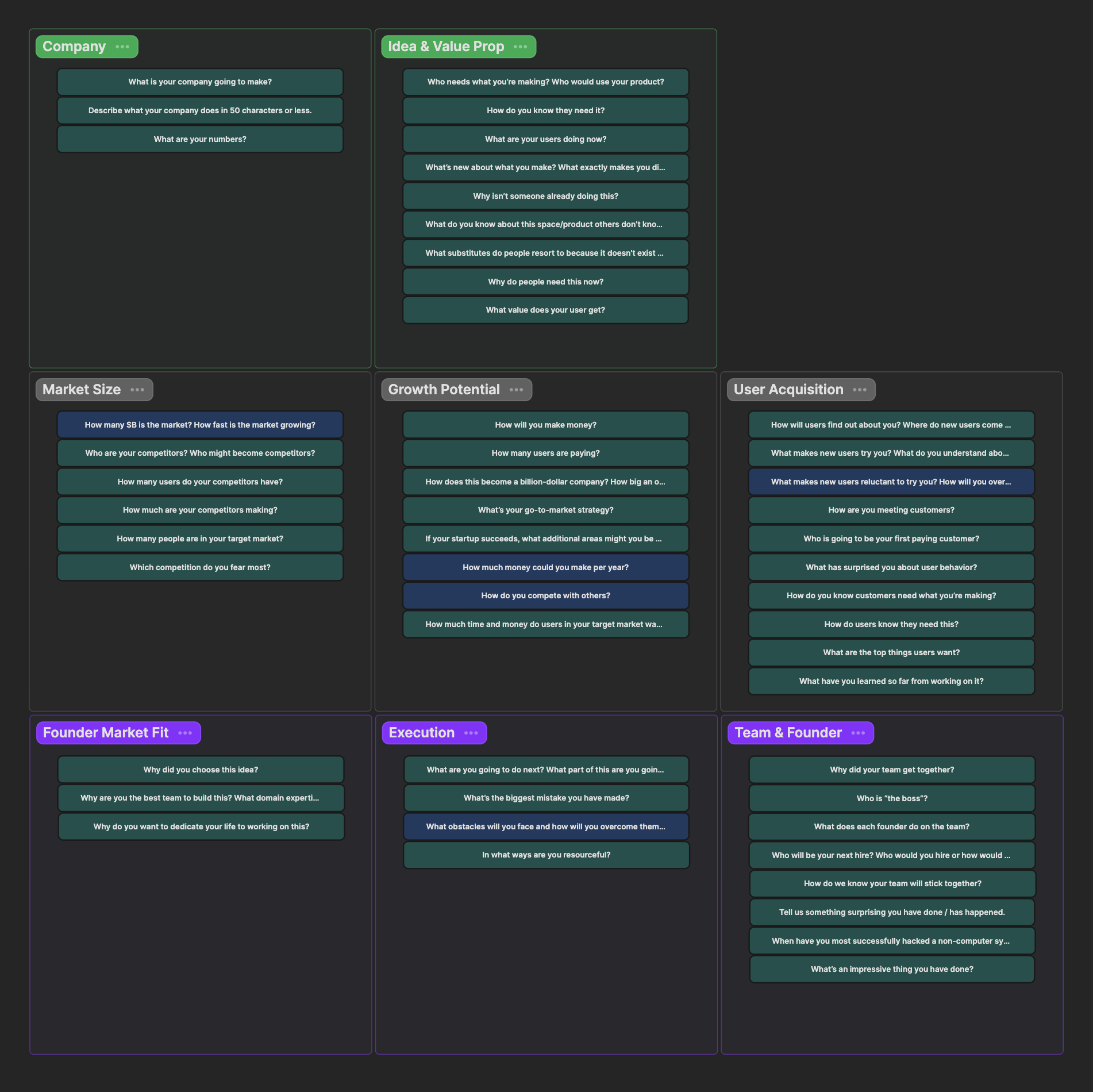
Plan the Minimal Viable Product - 打造最小可行性產品
A very common mistake for a first-time founder is to wait until all the features are in place before launching it. But in fact, it's much leaner to launch with just one or two features, acquire users, and iterate over and over again based on feedback. This is easier said than done, so I have a whiteboard where I compile strategies and methods for building a minimum viable product.
新手做產品很容易犯的一個錯誤,就是想等到所有功能都做出來以後才發布產品。但是事實上,更精實的作法是在只有一兩個功能的時候就推出產品,獲取用戶,不斷地根據反饋做一次又一次的迭代。這件事說起來容易,做起來困難,所以我有一個白板專門在整理打造最小可行性產品的策略和方法,讓我可以不斷地回頭來審視當下的做法有沒有可以改進的地方。
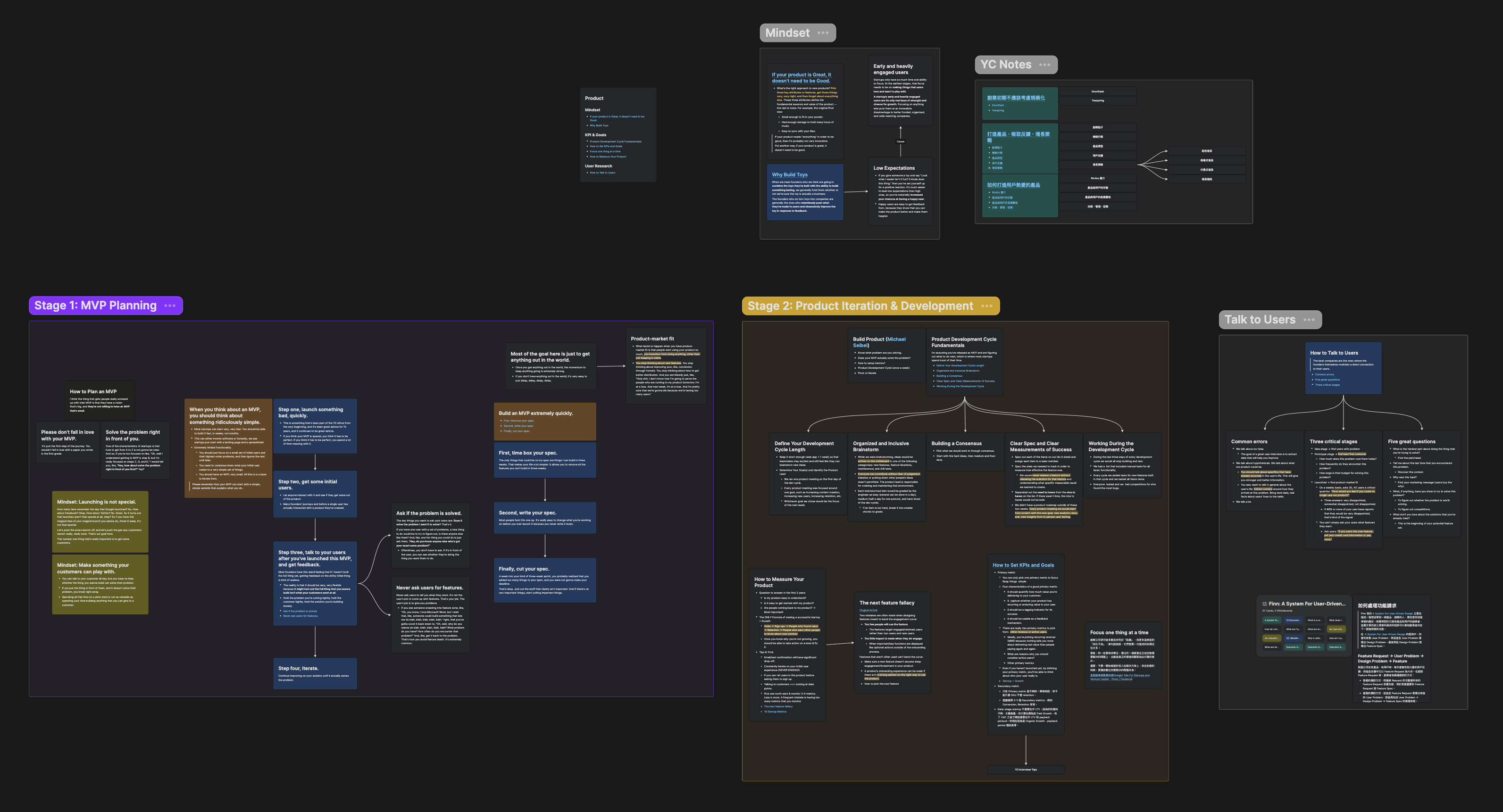
Organize Design Philosophy - 整理設計哲學
When designing products, I read a lot of relevant literature, break down the design concepts and philosophies that I might apply, and put them into a whiteboard to organize their relevance. Doing so helped me better plan the product's overall design and figure out what design philosophy to use.
在設計產品的當下,我會讀很多相關文獻,將我可能會應用到的設計理念和哲學拆解出來,放到一個白板裡頭組織他們的關聯性。這麼做能幫助我更好地去規劃產品整體設計,並搞清楚究竟應該使用什麼樣的設計哲學。
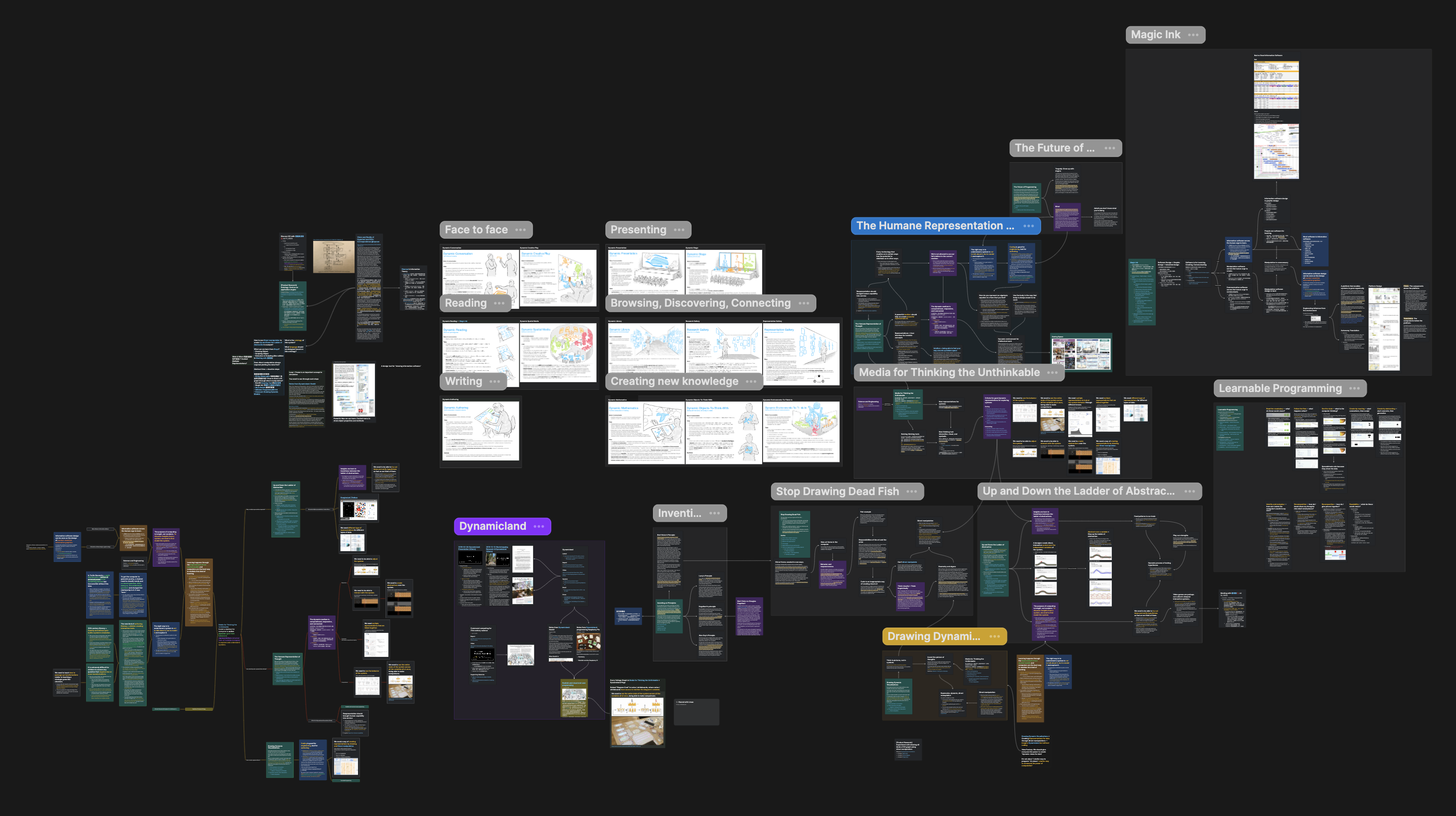
Plan the User Interview - 設計用戶訪談
Outside of making products, I spend most of my time talking to users. The purpose of these conversations is to find out three things: What problem is the user trying to solve with our product? Is the user our target audience? Where did this user find our product? Every question I ask extends from one of these three things. I have a whiteboard for planning user interview strategies, such as how to get from one question to the next, the purpose of each question, and so on.
除了做產品之外,我大部分的時間都花在和用戶對話上。這些對話的目的是想搞清楚三件事情:這個用戶想透過我們的產品解決的問題是什麼?這個用戶屬於我們的目標族群嗎?這個用戶是從哪裡發現我們的產品的?在和用戶對話時,我問的每一個問題基本上都是從這三件事情引申如來的。也因此,我有個白板專門用來規劃用戶訪談的策略,像是怎麼從一個問題接到下一個問題、每一個問題的目的是什麼等等。
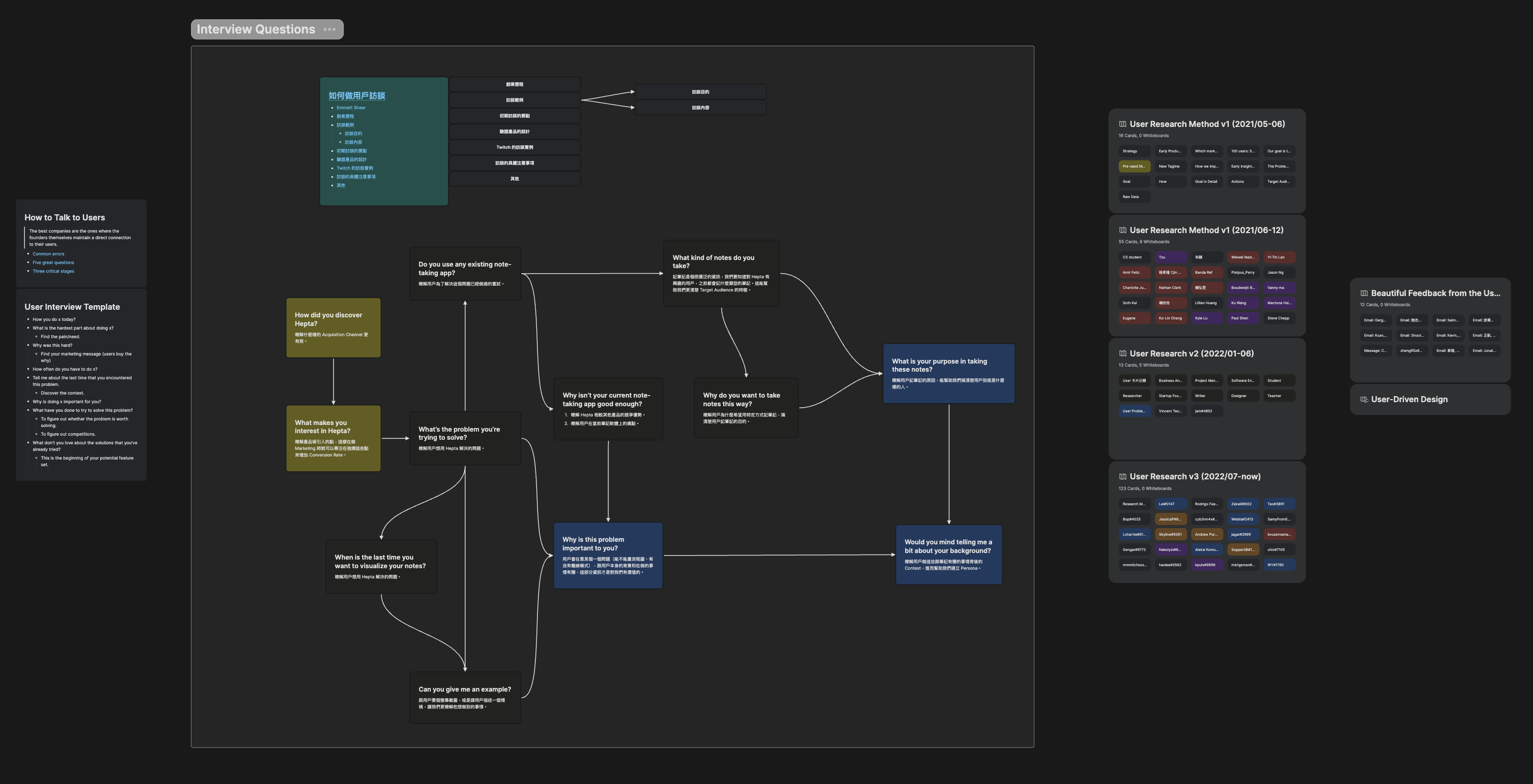
Conduct User Research - 做用戶研究
When interviewing a user, I take a lot of notes. After the interview, I will put these user cards on the user research whiteboard, arrange them according to different use cases, and highlight the important points. I also color-coded some user cards that I was focusing on. This visual classification helps me better analyze users' common needs and build personas for different types of users.
在訪談用戶的當下,我會替該用戶記下大量的訪談筆記。完成訪談後,我會將這些用戶筆記放到用戶研究的白板上,將這些用戶筆記根據不同的使用場景分門別類,並將重點用螢光色標記起來。我也會用顏色來標注一些重點關注的用戶筆記。這樣的視覺上的歸類能幫助我更好地分析用戶的共同需求,並替不同類型的用戶建立用戶的人物誌。
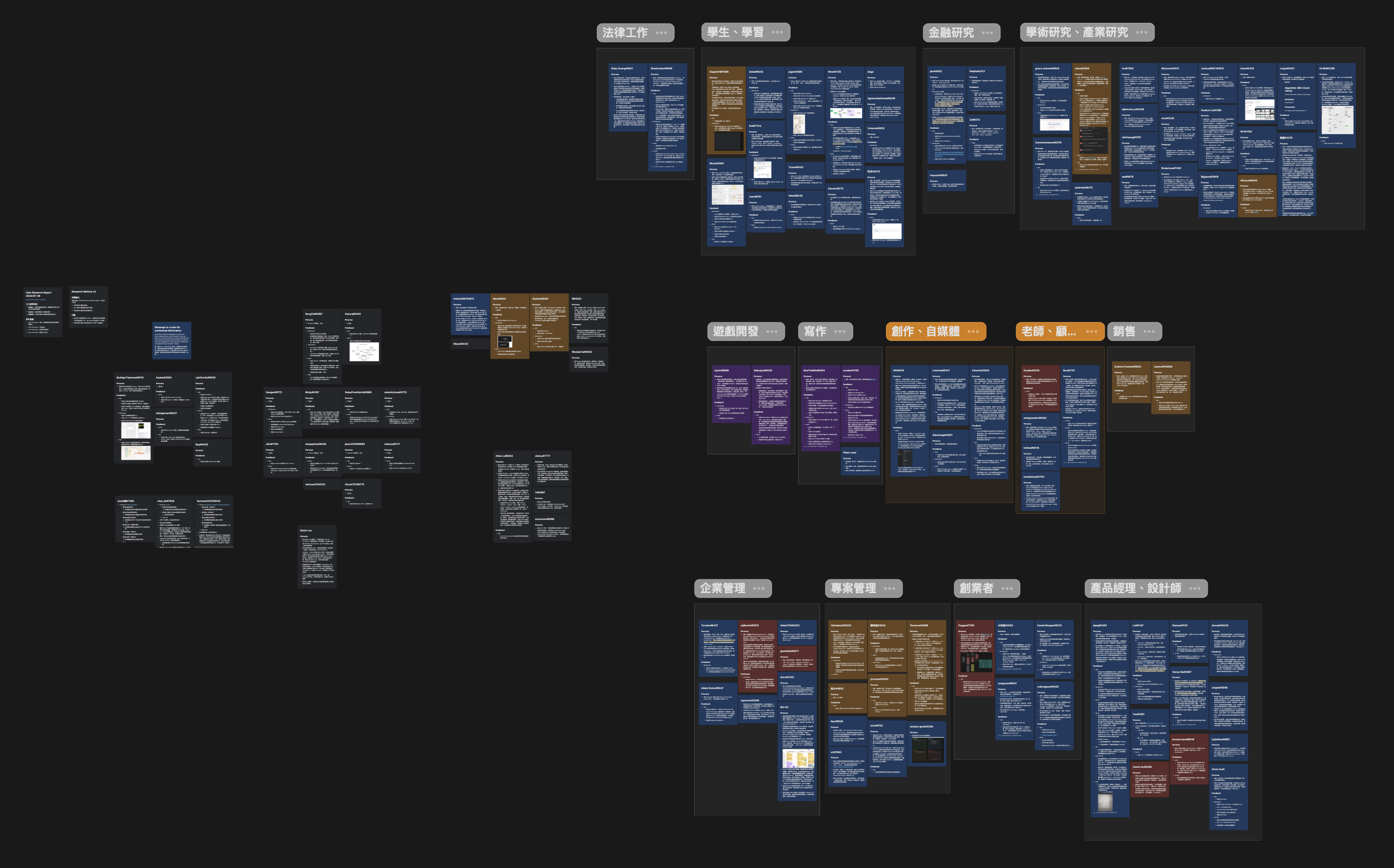
Write Product Diary - 寫產品日誌
I like to record ideas. I often have new insights in making products, sometimes a short sentence, sometimes a longer article. At such times, I would add cards to the whiteboard dedicated to the product log, quickly capture my thoughts and gradually organize them in the future.
我是個喜歡紀錄想法的人。在做產品的過程中我常常會有新的體悟,這些體悟有時只是短短一句話,有時是一篇短文。這種時候,我就會到產品日誌專用的白板裡頭新增卡片,快速將我的想法捕捉下來,未來再慢慢地把這些零散的想法組織起來。

Topic Learning (Data Analytics, Legal, Accounting)- 主題學習(法律、資料分析、會計)
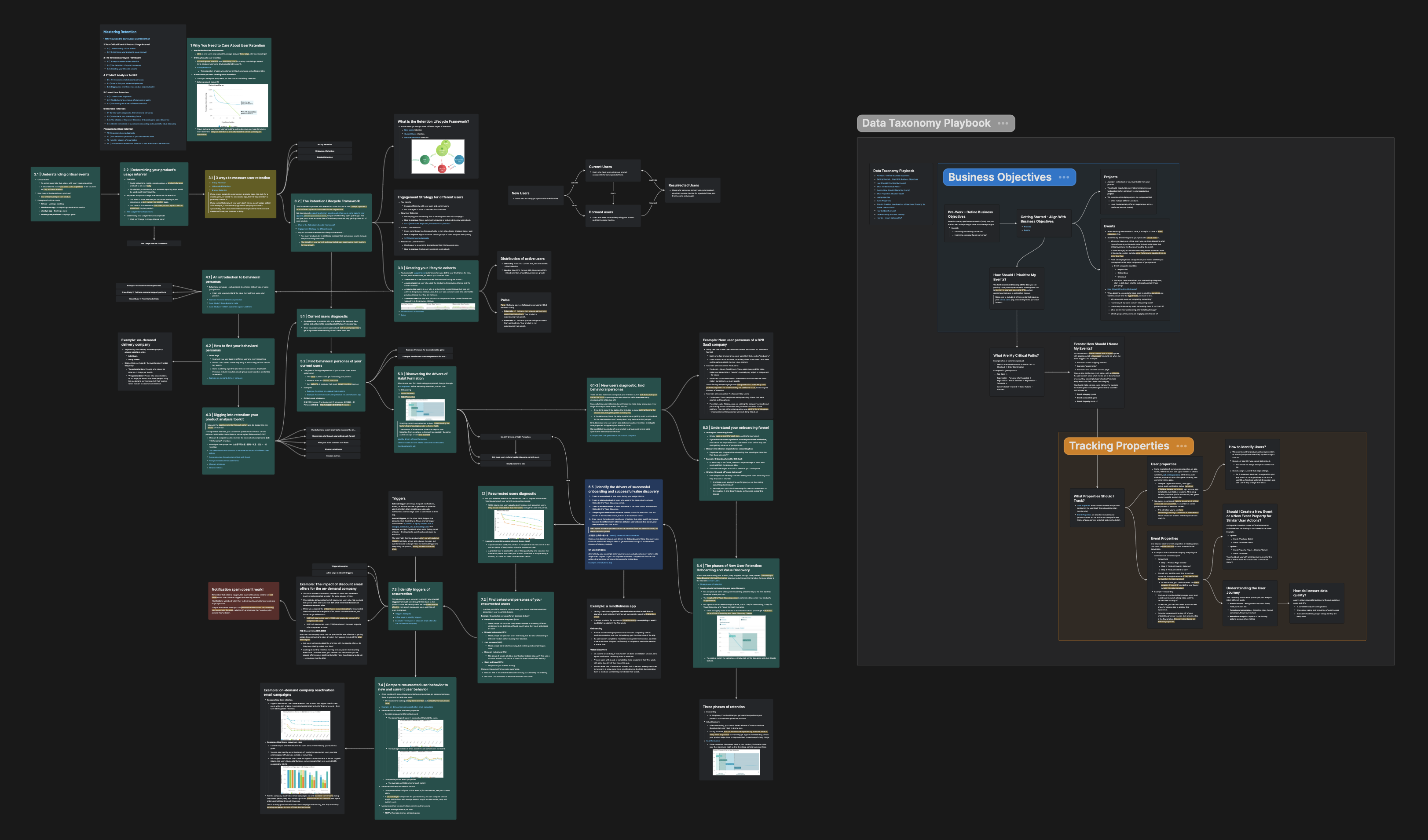
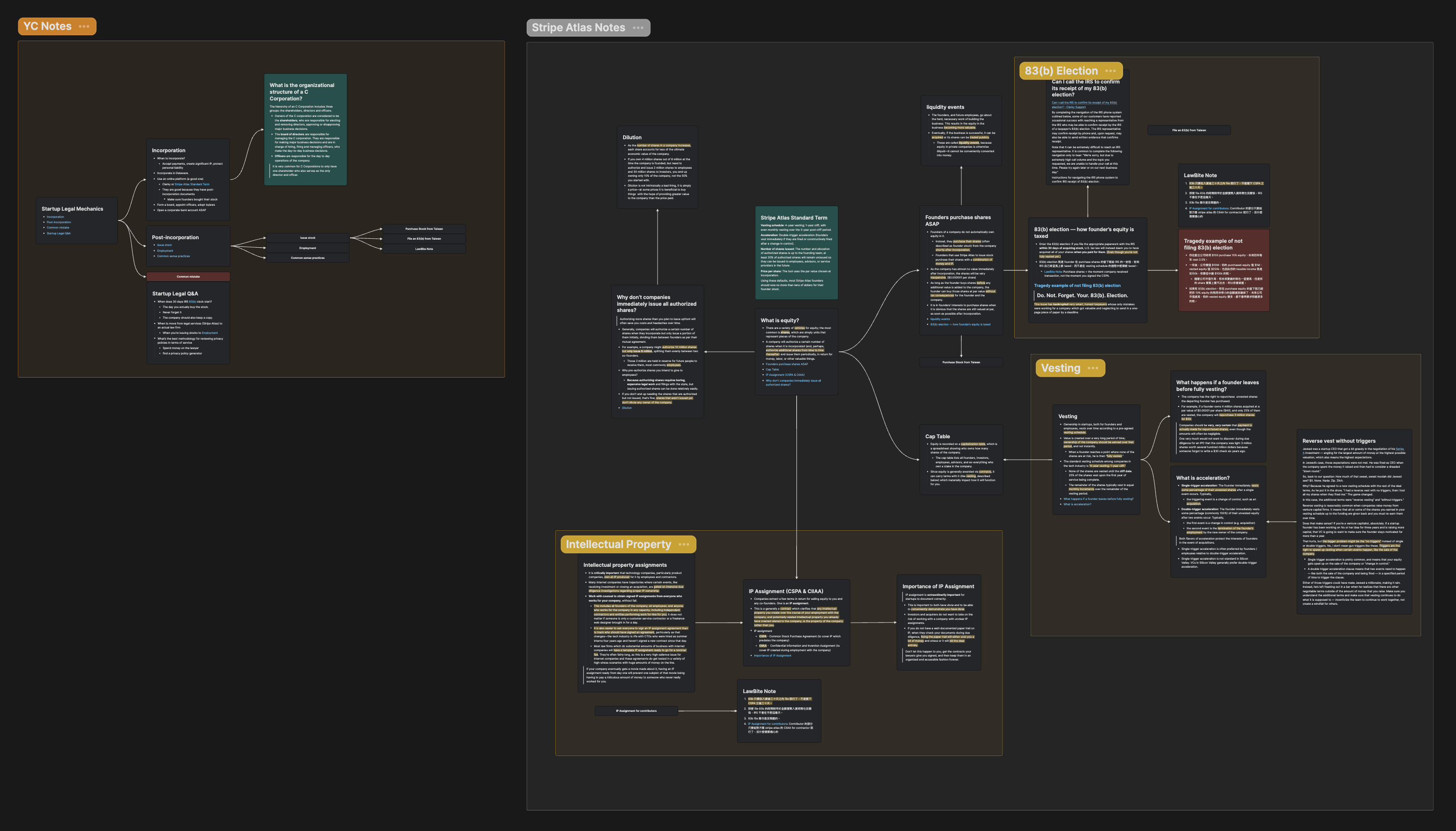
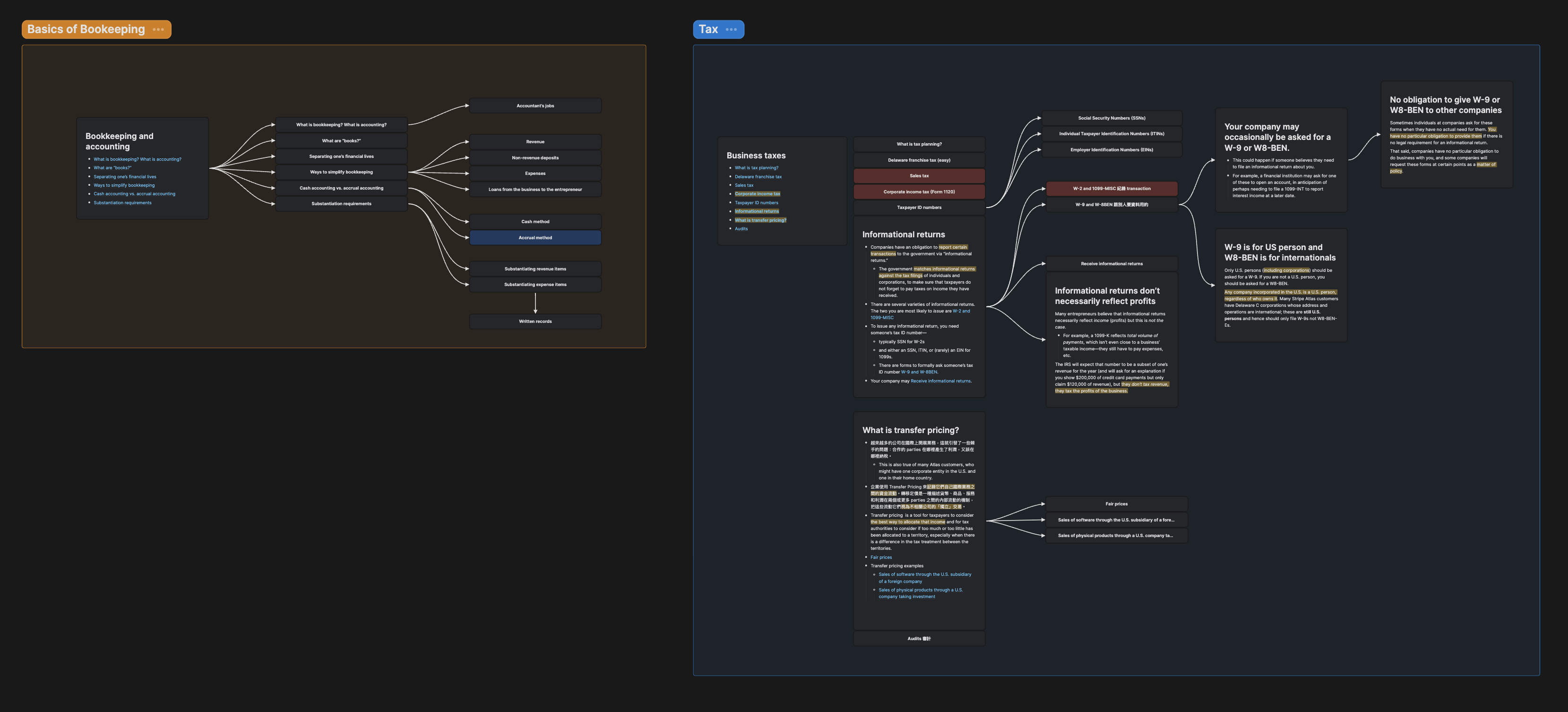
Organize everything in a giant world map - 打造知識地圖
On the home page, I will adjust the width and height of each whiteboard and arrange them into the shape of a world map. For example, all the whiteboards associated with my startup were placed on the map as Canada. Startup research is in the west, product research is in the north, user research is in the south, and personal ideas are in the east.
The benefit of this is that I can better remember the position of each whiteboard. Every time I tap into a whiteboard, I reinforce my visual memory of where the whiteboard is. When I have more whiteboards, this "memory palace" style of organizing information will make finding whiteboards as efficient as finding places on the Google Map.
在首頁,我會調整每個白板的長寬,將它們排版成世界地圖的形狀。舉例來說,所有跟我的公司有關的白板都被我放在地圖中的「加拿大」。商業研究放在西邊,產品研究放在北邊,用戶研究放在南邊,個人想法放在東邊。
這樣做的好處是我可以更好地記住每個白板的位置。每次我點進一個白板裡,就會強化一次我對這個白板所在位置的視覺記憶。當我的白板數量變多時,這種「記憶宮殿」式的資訊整理方式將會讓我找白板變得像在 Google Map 上找地點一樣有效率。
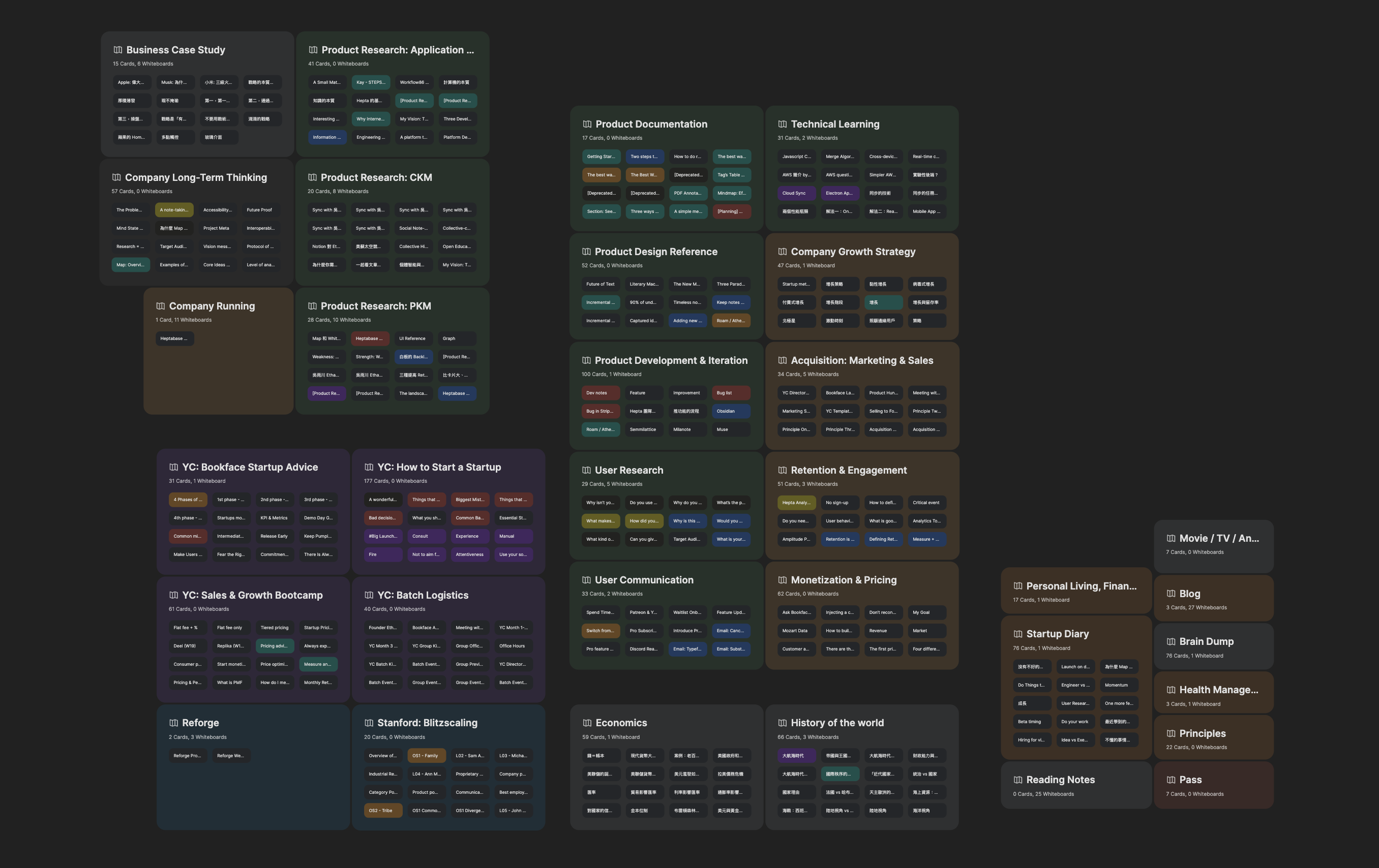
Creative Research - 創意研究
Hey, @Curio Heart here! I've found Heptabase's spatially-based workspace extremely helpful with developing my creative projects—particularly the weirdness of The Hartwell Tome, a website built around bite-sized fiction that is meant to be explored as much as read. While planning immersive fiction like this is far from easy, Heptabase has been helping ease this process considerably, particularly for the more ambitious parts of the project.
I also use Heptabase to help me organize and sort out more than just my creative work, too! Everything from concept mapping, self-exploration and analysis, and even self-management have been given places within Heptabase.
嘿,我是 Curio Heart,Heptabase 的早期用戶!我發現 Heptabase 所提供的二維工作空間對於我的創作非常有幫助——尤其是《哈特韋爾文集》(The Hartwell Tome) ,這是我在網路上發佈的一個互動式小說。構思這樣的互動式小說非常困難,但 Heptabase 非常有效地幫助我簡化了這個過程,特別是對於小說中更有野心的部分。
除了創作外,我也會用 Heptabase 來組織和整理其他東西,像是理解不同概念之間的關係、探索和分析自我。我甚至會用 Heptabase 來做自我管理!
Visualizing branching and alternate paths... 視覺化故事的分支和不同發展方向
One of the challenges of writing any kind of interactive fiction is making sure that all links are meaningful. Some links may lead to information, while others add new elements to the story—like small branches with extra information, or alternate perspectives to events.
Laying out scene cards and descriptively connecting them allows me to visualize the flow of story elements and spot where stories intentionally dead-end with some extraneous information, and where alternate perspectives branch off of the main story.
寫互動式小說最大的挑戰之一,就是確保所有的連結都是有意義的。有些連結可能會指向特定資訊,有些則會為故事添加新元素——比如帶有額外訊息的支線,或是針對同一個事件的不同視角。
我會將不同的故事場景做成卡片,並在這些卡片之間建立有描述的連接。這讓我能夠一眼就清楚故事是怎麼流動的,也更容易安排讓讀者在某些地方因爲一些不相干的信息而陷入僵局、在另一些地方則用不同的視角將故事從主線分支出去。
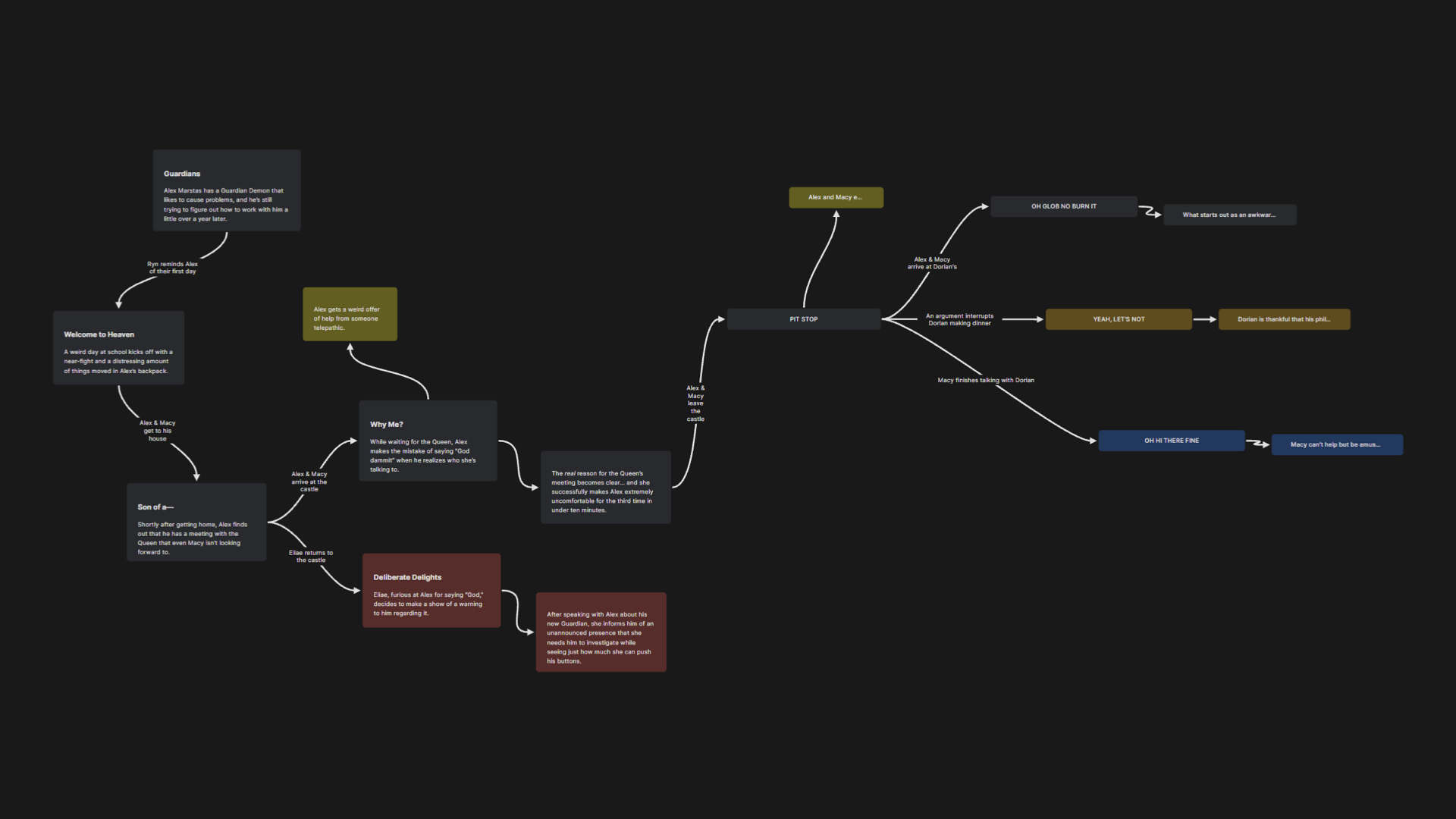
... and using lanes to visualize them as timelines 呈現故事發展的時間線
While visualizing the flow of stories can be incredibly helpful when figuring out how and where stories connect together, sometimes I find a linear to be more useful to view the overall progression of the story. In a sense, this builds an artificial timeline of the story from start to finish... even if not all of it is necessarily in chronologic order.
雖然將故事流程視覺化能夠幫助我明確故事之間的聯繫,但也有些時候,線性的呈現方式更有助於我觀察故事的整體進程。所以我在另一個白板中建立了一個人造時間線……即便不是所有的事件都會按時間順序排列。
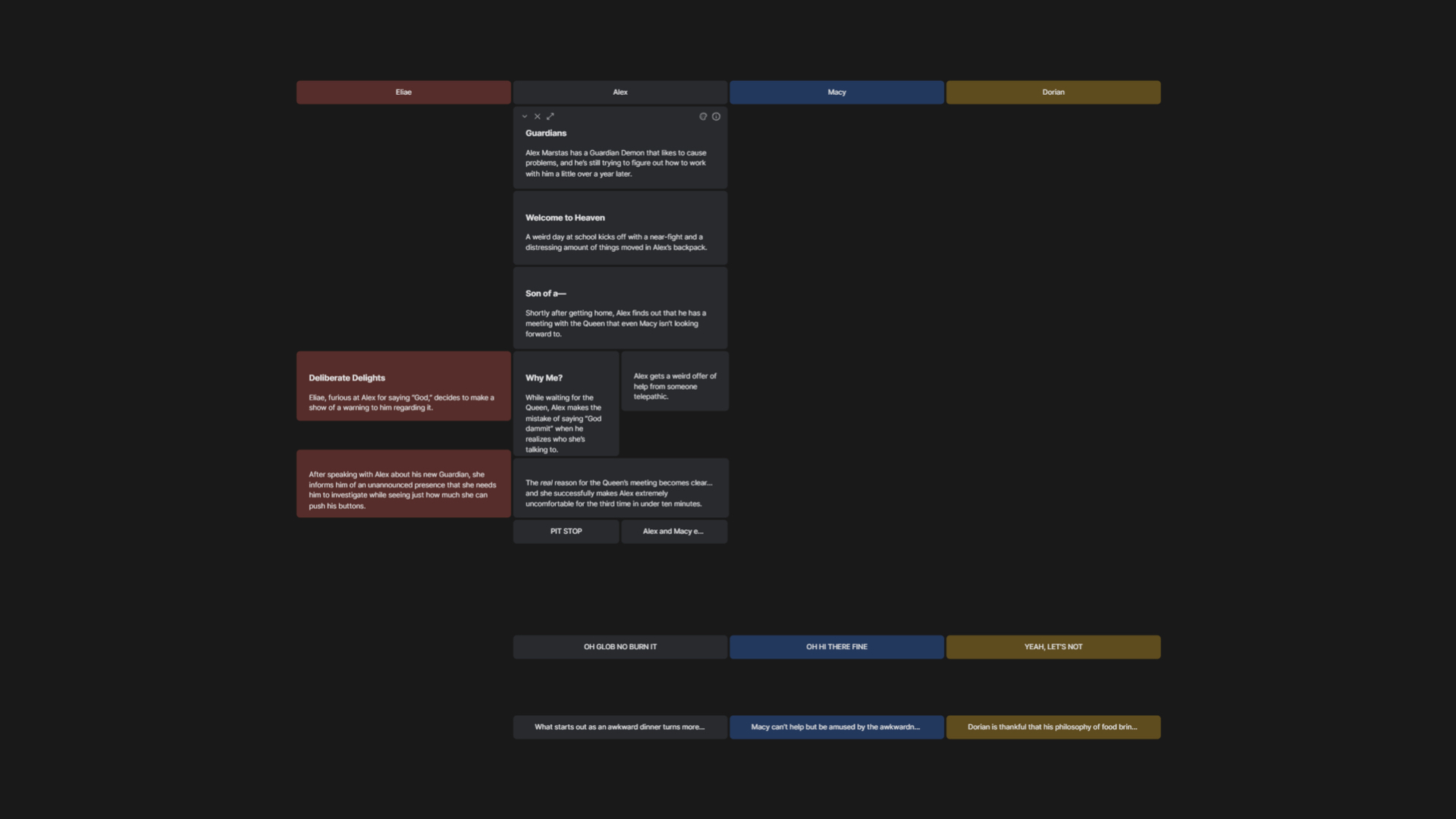
Developing abstract systems for describing relative power 設計故事的世界觀和能力設定
One of the tricks I've had to learn while writing is coming up with systems to help make sure I'm writing interactions consistently. Since my writing involves limitless growth of some characters, I regularly put myself in a position where I need to figure out if, how, and why something new might be a problem, and for whom.
In addition to understanding why certain aspects of growth are measured, I try to keep track of what I intentionally leave out, too—it's for my own benefit far more than my readers, as I very strongly believe in being as explicit with design as possible.
在寫作過程中,我必須學習的其中一個技巧,就是構思出一套系統來確保我寫出來的東西是一致的。由於我的寫作涉及到某些角色們的持續成長,我經常會需要去思考,一個新的事件會如何對哪些角色帶來什麼樣的成長。
除了要測量角色們的成長以外,我還會追蹤那些我之前故意遺漏沒寫的內容,因為我堅信故事設計要盡可能明確——這主要是為了我自己,而不是我的讀者。
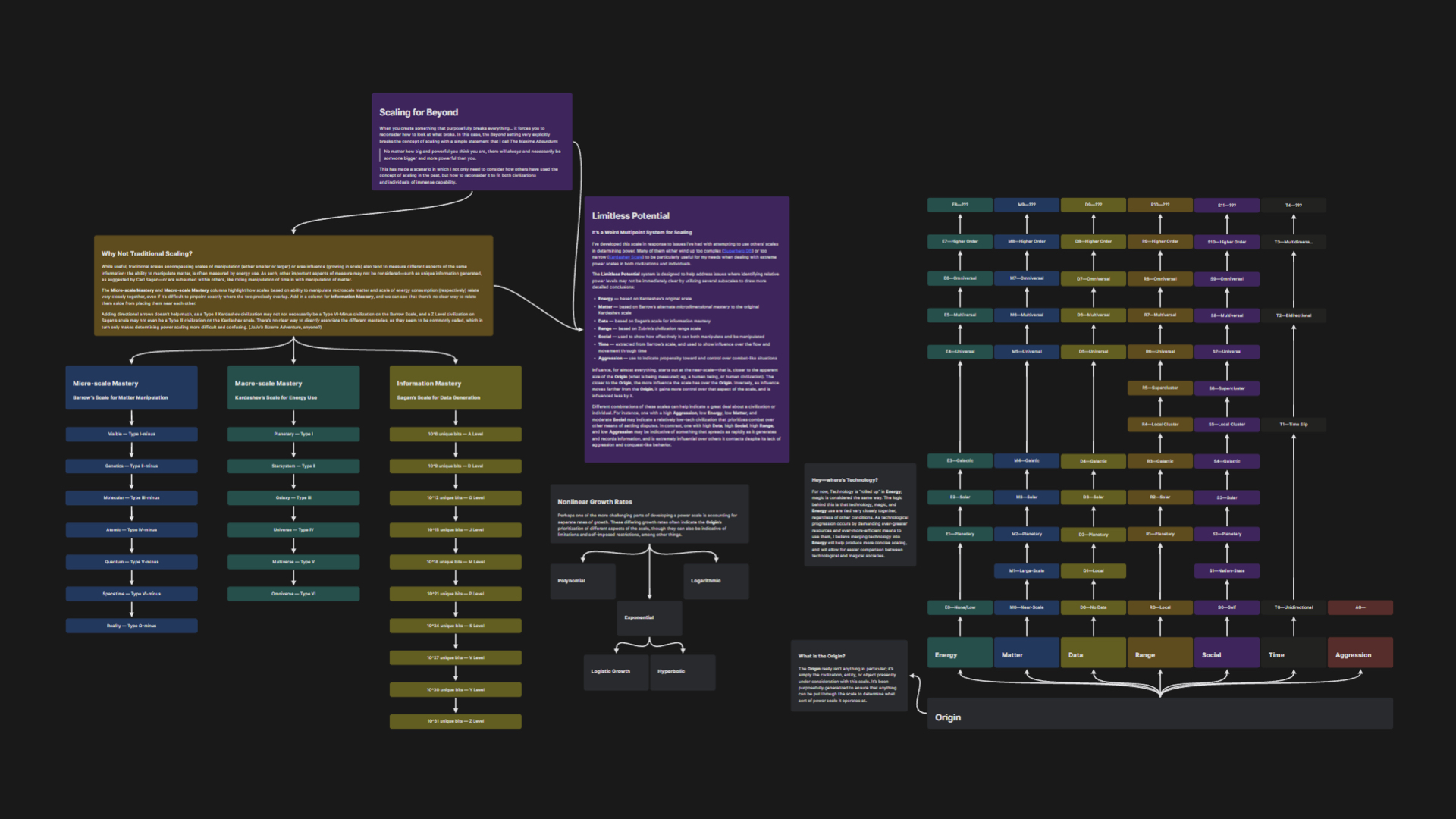
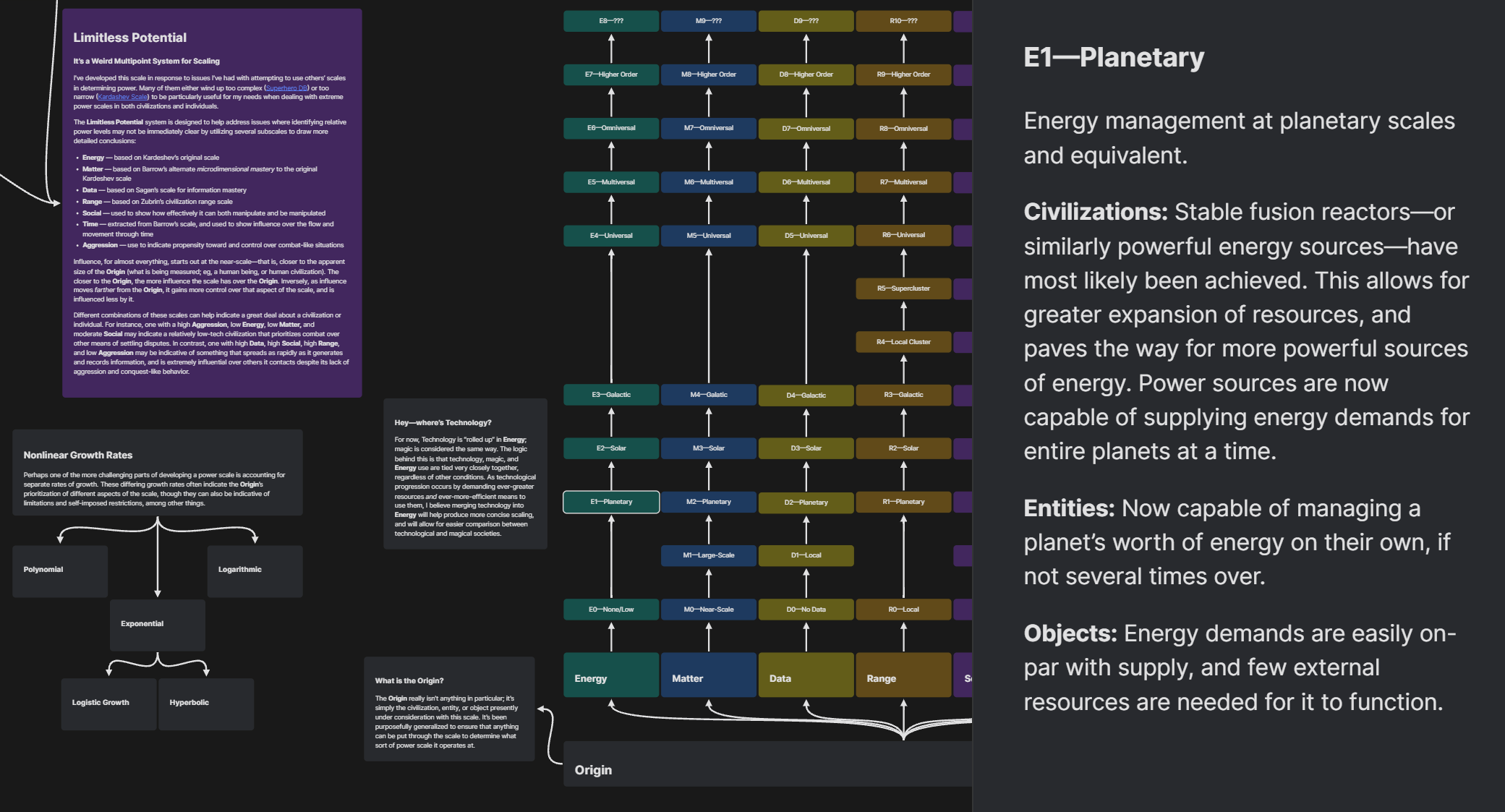
Creating a custom task management solution 打造專屬的任務管理方案
As someone with ADHD, one of my biggest struggles outside of my creative work has been managing my tasks. It's felt like every system has tried to box me into thinking in a way that is not only counterproductive, but effectively erases my own internal prioritization methods. After struggling with various apps and methods for years, I finally decided to develop my own system to alleviate some of these issues by breaking down the core ideas of task management as I understand them, and re-imagining how they might better work with my needs.
身為一個有過動症的人,除了創作之外,對我來說最大的挑戰就是如何有效的管理我要做的事情。我嘗試過很多不同的系統,但它們感覺都在逼我用一種適得其反的方式思考,甚至讓我無法照著我內心期望的方式來排序事情的優先排序。在多年來嘗試過各種 App 和方法後,我最後決定在 Heptabase 上開發自己的任務管理系統。我將過去所學到的任務管理的核心理念抽絲剝繭出來,並重新想象如何利用這些理念更好地滿足我的需求。
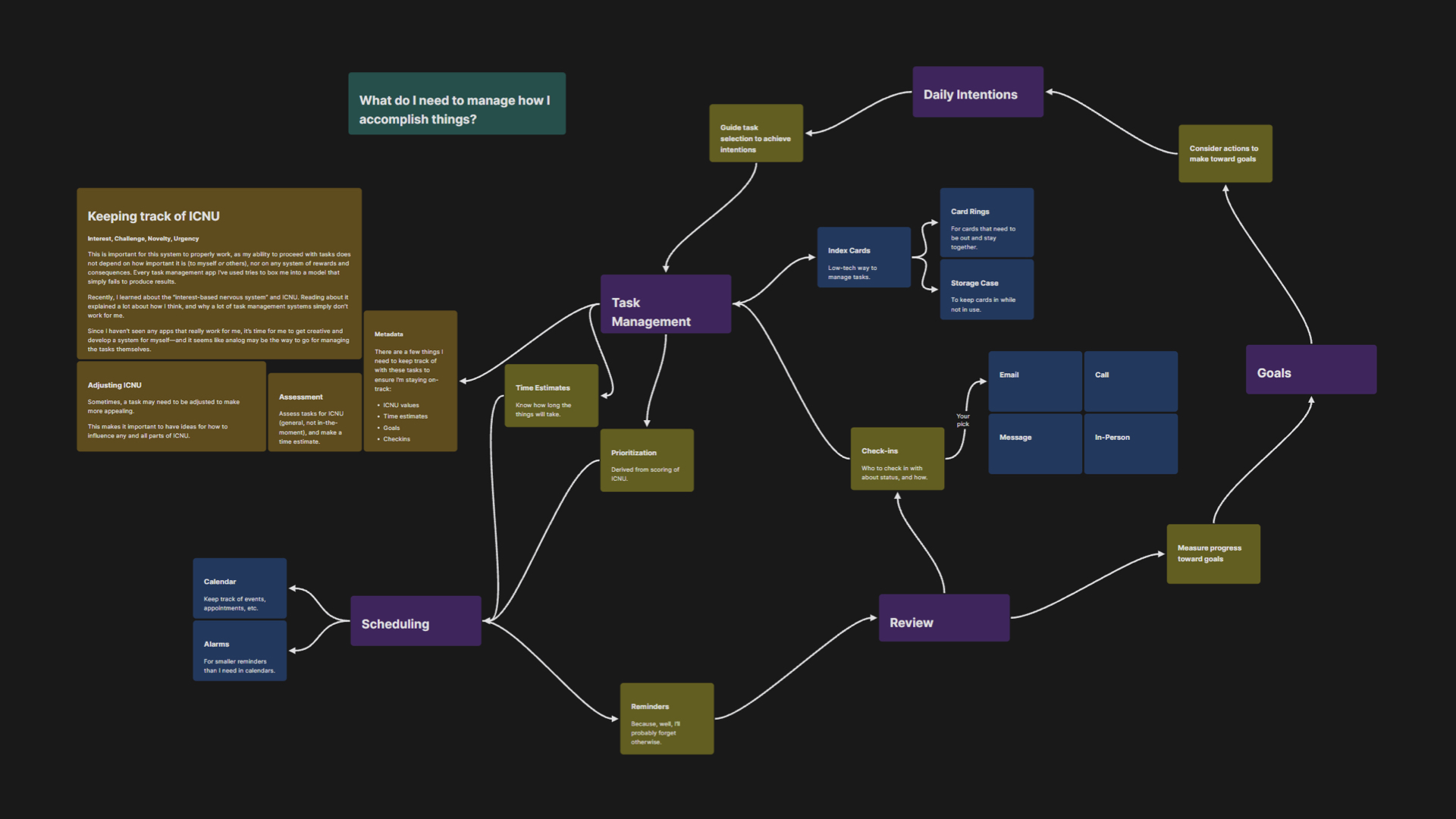
Market Research - 市場研究
Hi, I'm Phuong. I am an aspiring entrepreneur and an Edtech enthusiast from Vietnam. I have been using Heptabase for 2-3 months and it has helped me a lot with brainstorming for my research topic and visualize my thinking as I gather information and data from different sources.
Things can get overwhelmed and messy quickly when you dive deep into research as the more you research, the more you realize you have no idea about. Heptabase helps me keep track of where my research is going and know what to do when I'm going into a rabbit hole and drifting from my initial research questions and goal.
This summer, I have been using Heptabase for my independent research such as the one on the future of Edtech in Vietnam I am about to show you below. And I am sure I can apply the same process to my school or work research in the future. You will notice that my organization of the cards on my whiteboard is very simple because I like to keep it simple on the design and use Heptabase mostly for a brain dump and connecting my thoughts with experts'.
嗨,我是 Phuong。我是來自越南的教育科技愛好者,也是一名企業家。我已經使用 Heptabase 兩到三個月了,它對我構思我的研究主題非常有幫助,並且能在我從不同地方收集資訊和數據時持續將我的思考給視覺化。
在過去,每當我深入研究一個主題時,常常會感到混亂且不堪重負。研究愈深,愈是意識到自己一無所知。Heptabase 幫助我很有效地追蹤我的研究方向,讓我能清楚知道在偏離研究目標時該如何調整作法。
今年夏天,我一直在使用 Heptabase 進行我的獨立研究。下面我將展示的例子是我所做的、關於越南教育科技的未來的研究。我相信我將來可以將同樣的流程應用到我的學校和工作研究中。你會注意到我在白板上對卡片的組織是非常簡單的,因為我喜歡在設計上保持簡潔。我喜歡快速的把我大腦中的想法一股腦地丟進 Heptabase,並將我的想法與專家的想法連繫在一起。
Identify the type of audience 識別目標受眾
Firstly, I find it helpful to identify the type of audience, my current state of understanding, research goal, and complexity of the topic before diving right into researching. This step helps keep me grounded with my current knowledge, my goal, and direction with this research.
One of the features Heptabase has that I love is that I can open a window of the card I am writing on the side as shown below. The two yellow cards you see here are cards that I have created on a different whiteboard that have relevance to my Edtech research here. There are research frameworks or processes that I've learned from other people that I would love to reference next time I do my research. Heptabase allows me to pull up these old cards to remind myself of things I should identify first every time I start my research. Heptabase makes it easier to pull up relevant knowledge within your brain that you might not immediately remember or think of.
首先,我發現在開始深入研究任何主題之前,先確定好目標受眾、我當前的理解狀態、研究目標和主題的複雜性是非常有幫助的。這能幫助我為我的研究目標和方向建立一個良好的基礎。
我非常喜歡 Heptabase 的其中一個功能,就是我可以把白板上的卡片開到右邊側欄上(如下圖所示)。在這張圖中,你們看到的這兩張黃色卡片是我在其他白板上建立的卡片,這些卡片的內容與我現在在做的教育科技研究有關。Heptabase 的優點是它讓我能在每次開始研究的時候,把這些舊卡片拿出來放到當前的白板上提醒自己。這讓我能更容易地提取出那些大腦平常沒辦法立即想到的知識,將這些知識應用到當前的研究上。
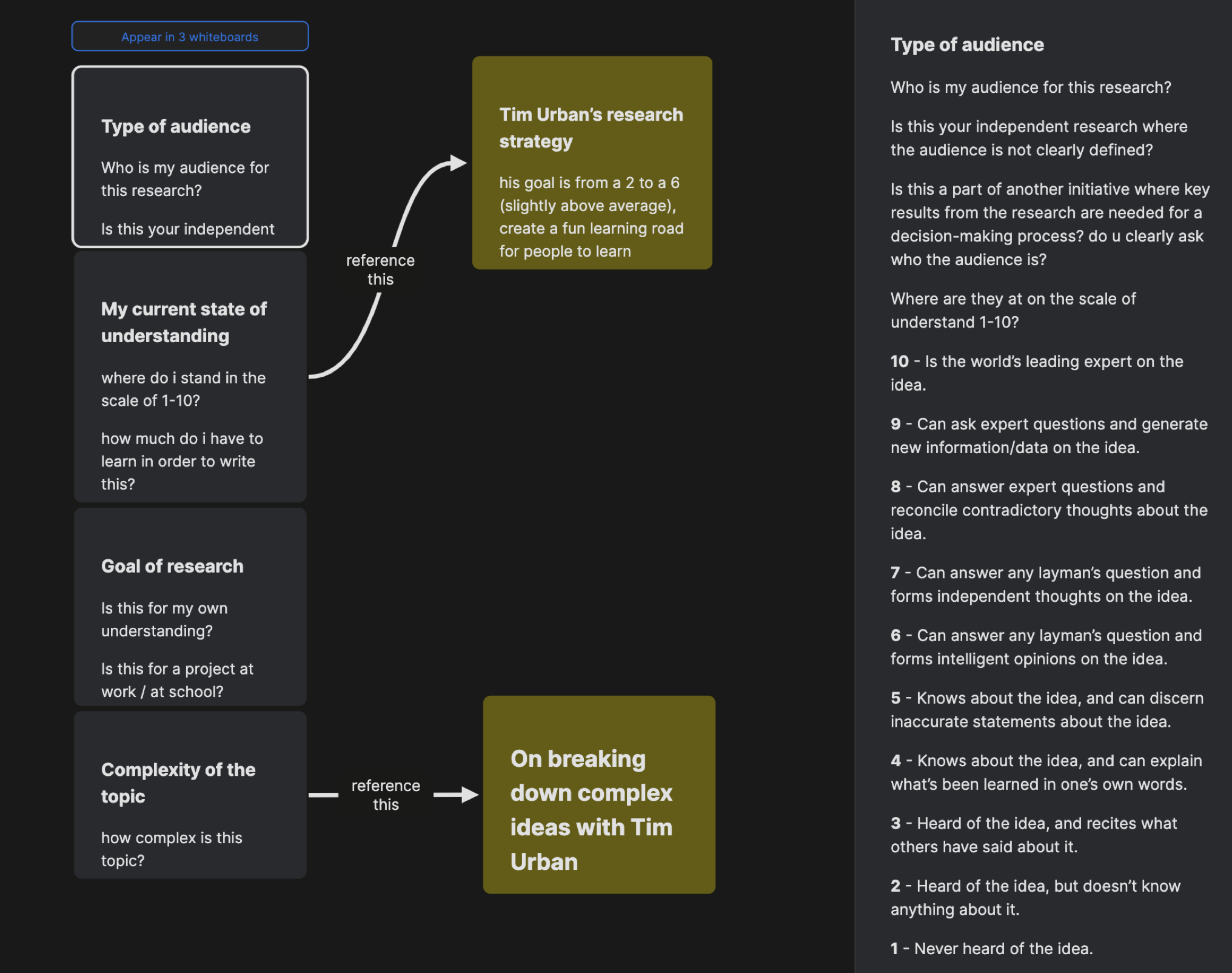
Break down a big topic into smaller ones 將大主題拆解成小主題
Secondly, I break down my big topic into smaller ones. I go from what Edtech looks like on a global scale, to regional (Southeast Asia), and to a specific country I am interested in (Vietnam). This helps me compare and contrast Edtech scene across different geographical locations.
I like how Heptabase allows me to quickly and smoothly break down a topic into relevant subtopics that I want to explore and not lose track of the overall question that I am interested in. For example, from the first topic break down, I want to learn more about what specifically makes up the Edtech scene in market in Southeast Asia by looking at the sectors, clusters, and valuation. Then, I want to go deeper into Vietnam's market and the Edtech clusters there.
By visualizing the market in Southeast Asia and Vietnam side by side, I am able to identify where Vietnam is lagging behind its peers in the region and where opportunities lie.
我會用 Heptabase 將大的主題拆解成小的主題。我會把全球範圍內的教育科技,拆解成不同區域(東南亞),再到我感興趣的特定國家(越南)。這有助於我比對教育科技在不同地理位置上的應用場景。
我很喜歡 Heptabase 能讓我快速且順利地將一個主題分解成我想要探索的相關子主題,並且不會忘記我感興趣的整體問題。例如,從第一個主題分解,我想通過查看行業、集群和估值,瞭解更多關於東南亞教育科技市場的具體組成部分。然後,我想深入越南市場和那裡的教育科技集群。
通過把東南亞和越南的市場放在一起,我能夠識別出越南在該地區哪些地方落後於其他國家,哪些地方存在機會。
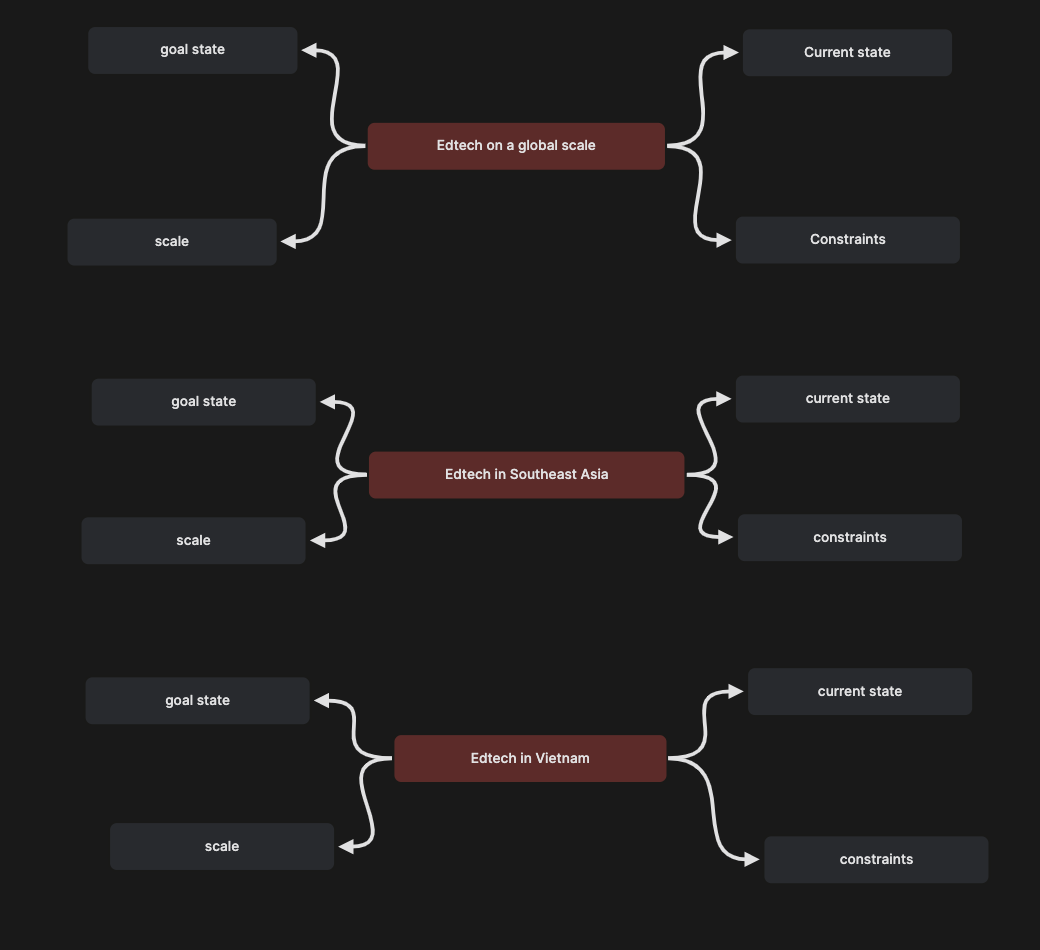

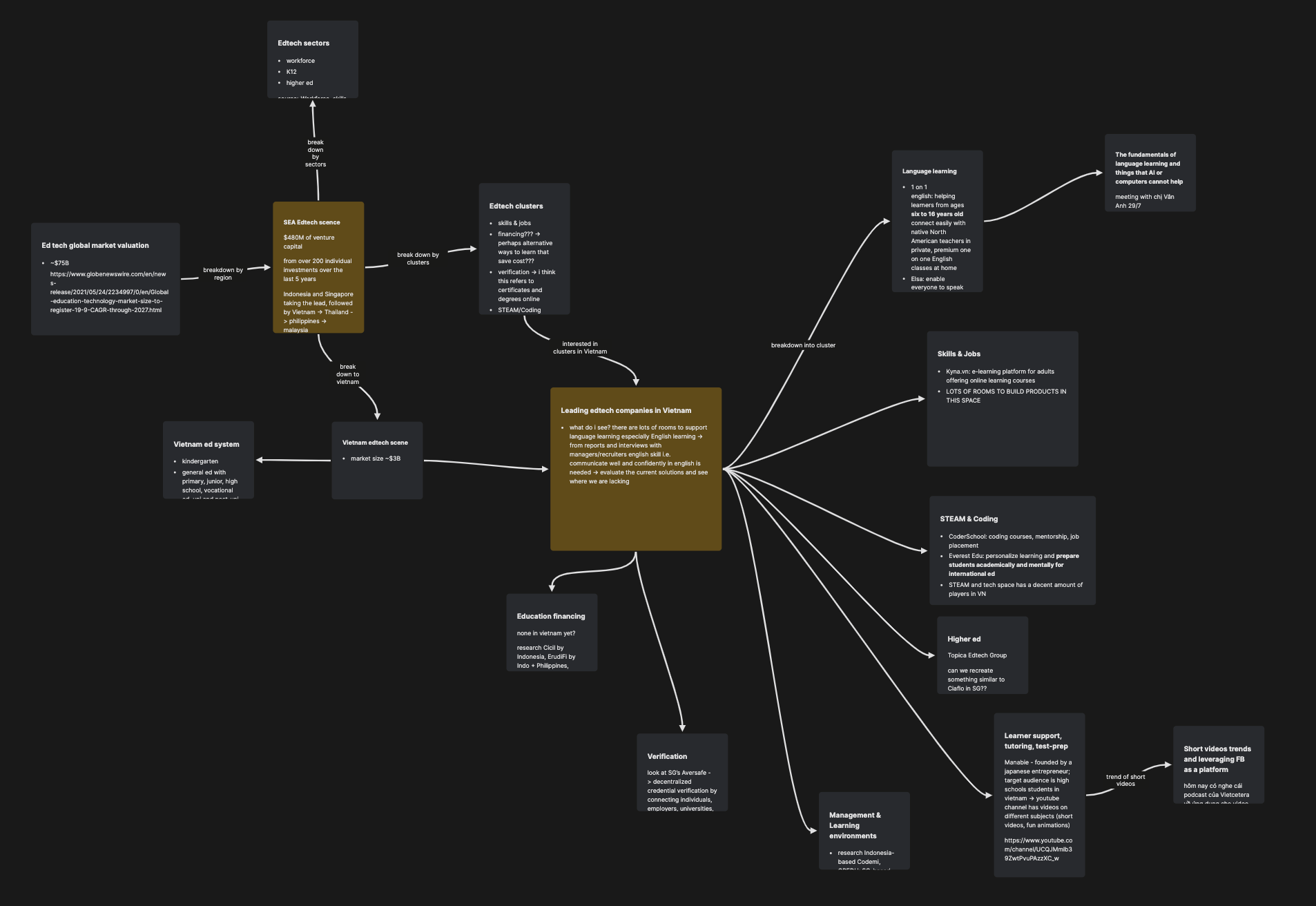
Note down my questions right away 即時地紀錄我的問題
Along the way, new ideas about the topic I am researching pop up in my head and I can just start a new card on the same whiteboard so I don't lose my ideas later on. Finally, what I love about having a dynamic whiteboard that represents both my thoughts and information gathered is that questions often quickly arise. Then, I can note down my questions right away, assign them as different color, and showcase what pieces of information connect to those questions. Such as the example of the orange card below. I will want to come back to these questions and research further and with the cards that are connected, I know exactly where I can start.
在研究過程中,我的腦海中總是會不斷地浮現出新的點子。白板的好處是我可以快速為這些點子建立新的卡片,這樣我就不會怕忘記它們。我的白板是動態的,裡頭既包含了我的想法,也包含了我收集到的資訊。我喜歡白板的主要原因是,問題常常會不斷地浮現,而有了白板後,我就可以馬上記下我的問題,用不同的顏色來標記它們,並展示與這些問題相關的資訊片段。例如下面的橘色卡片,我未來會要繼續去思考裡頭的問題時,我就可以回到這個白板,看看這張卡片和哪些卡片有連結。這讓我清楚地知道要如何開始思考這個問題。
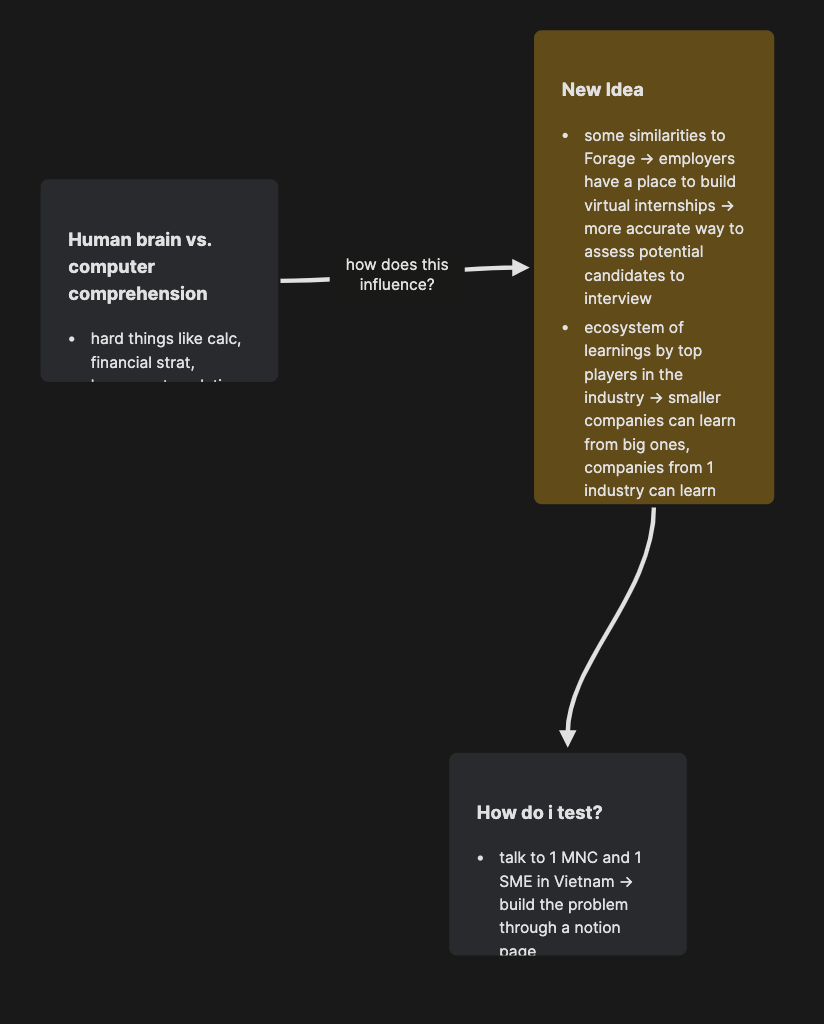
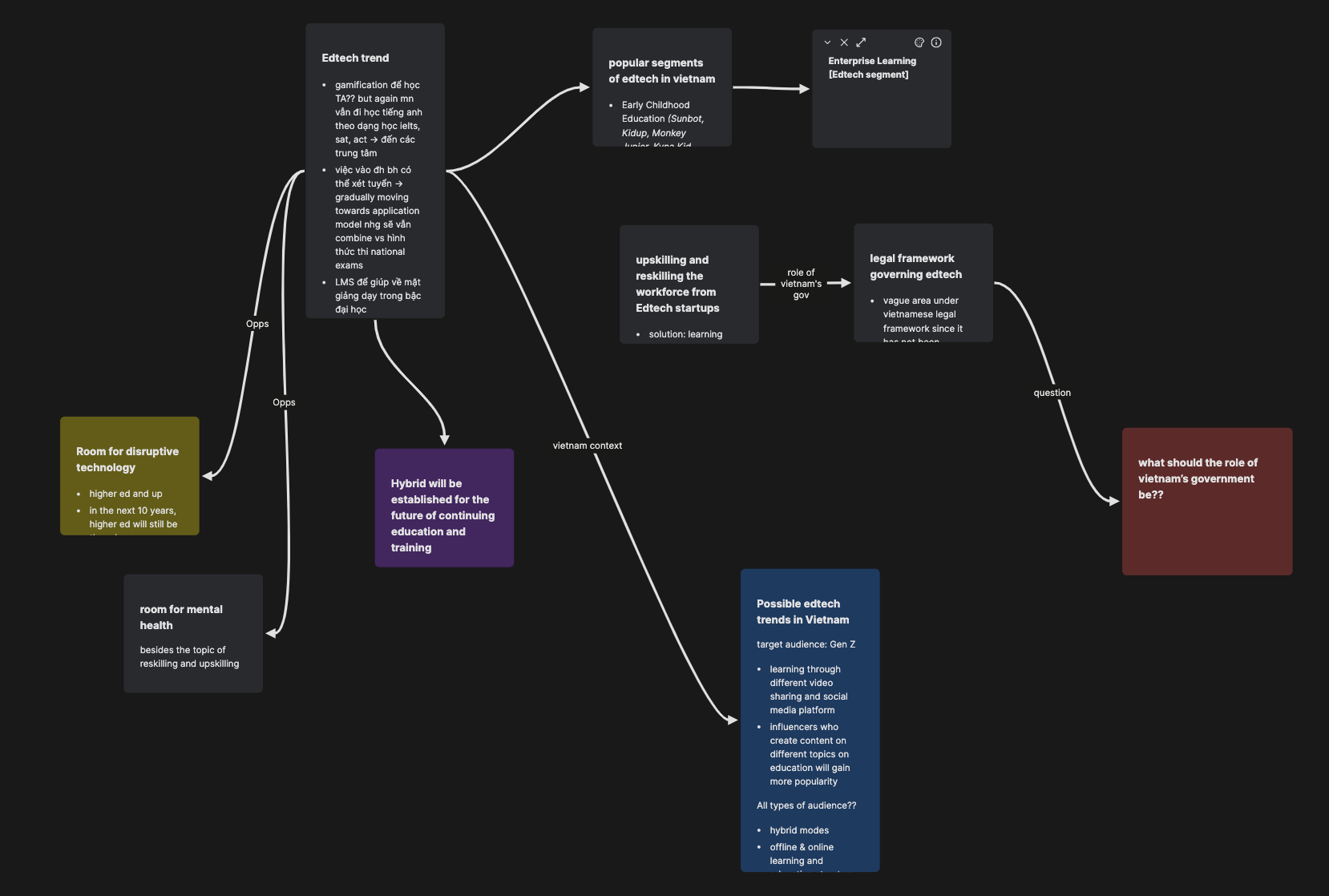
Make sense of a complex topic 理解複雜的研究主題
Doing research involves a lot of thinking and digging into old knowledge that exists in your brain alongside gathering new information from different sources. With each card, I have space to write down my thoughts, new information I have learned, or questions that arise. Then, I also see where that card or piece of information relates to my overall research topic. There is a quote from James Clear that says, "Innovation usually means connecting previously unconnected concepts."
As an aspiring entrepreneur, I love to innovate and Heptabase helps me connect seemingly unrelated pieces of information that manifest into new questions and ideas, and connect multiple pieces of information on a complex topic to make better sense of it.
做研究不只需要大量的思考,也需要挖掘很多存在大腦中的既有知識,以及同時從不同的來源收集新資訊。在 Heptabase 的每一張卡片上,我能寫下我的想法,我學到的新資訊,或是我想到的新問題。我能看到這些卡片和資訊與我的整體研究主題相關的地方。正如同 James Clear 曾說過:「創新通常意味著將之前不相關的概念聯繫起來。」
作為一名有抱負的企業家,我喜歡創新,而 Heptabase 幫助我將看似無關的信息片段連接起來,形成新的問題和想法,並將複雜主題的多個信息片段連接起來,以更好地理解它。
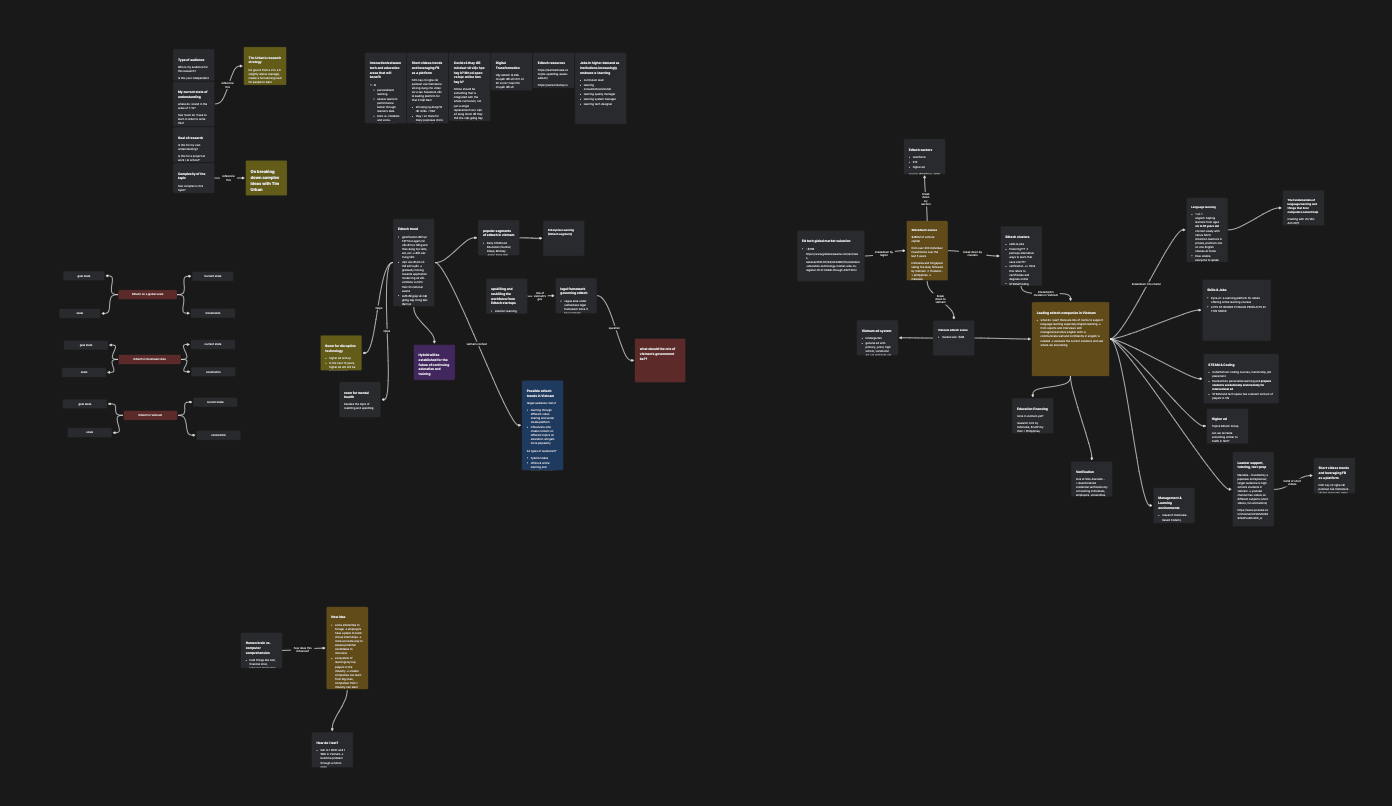
Topic Learning - 主題學習
Medicine Learning - 學習醫學
Hi, I am @鄭景鴻, a fifth-year medical student at National Taiwan University. I'm currently interning in a hospital. In the past, when learning medical science, I usually took notes in fragments due to the characteristics of internship courses, which made them very varied and messy. I always need to sort them out after class to absorb what I've learned fully.
However, all the note-taking apps I've been using only allow me to organize notes in a hierarchy. The link between different knowledge is fragile, so I often have to switch between notes and reorganize them, which has wasted a lot of time and made me less productive.
The best thing about Heptabase is that I can take notes on cards very quickly. I can combine these cards into different knowledge networks in different thinking contexts and see the connections immediately. I think Heptabase is the best tool for learning new things.
嗨,我是@鄭景鴻 ,台大醫學系的大五生,現在正在醫院實習。過去在學習醫學的過程中,由於實習課程的特性,因此在紀錄知識時,通常都是非常片段性的快速記下來,而且非常的繁多且雜亂,一定要在課後回去整理才能夠好好吸收。
但是過去的筆記程式,只能讓我以分層式的去做整理,在做不同知識的相關連結時非常的薄弱,因此常常寫過的筆記又要翻來翻去重新整理,才能做出比較完整的筆記,不過這些工程曠日廢時,反倒讓做筆記這件事情形成反效果。
Heptabase 最大的好處,就是我可以隨時將我片段的知識,用卡片記錄下來,之後在不同的思考邏輯脈絡時,可以隨時新架構不同的知識網,幫助我同樣的知識卡片可以利用各種脈絡去做學習,並且快速看到他們之間的連結性,我認為 Heptabase 是一款學習新知識上最棒的工具。
